法律英语
- 格式:doc
- 大小:45.50 KB
- 文档页数:6
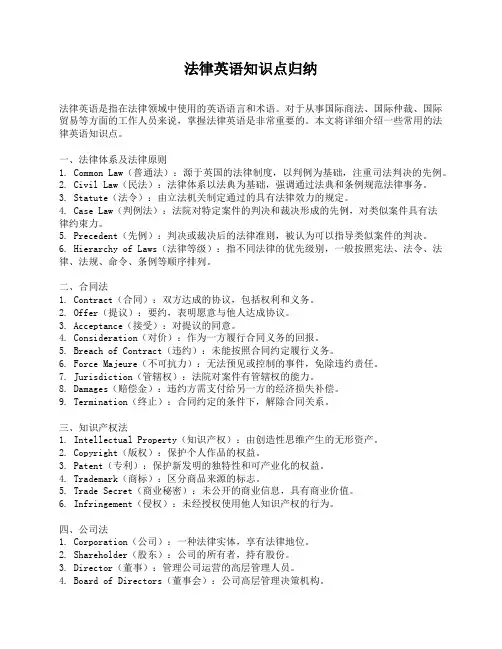
法律英语知识点归纳法律英语是指在法律领域中使用的英语语言和术语。
对于从事国际商法、国际仲裁、国际贸易等方面的工作人员来说,掌握法律英语是非常重要的。
本文将详细介绍一些常用的法律英语知识点。
一、法律体系及法律原则1. Common Law(普通法):源于英国的法律制度,以判例为基础,注重司法判决的先例。
2. Civil Law(民法):法律体系以法典为基础,强调通过法典和条例规范法律事务。
3. Statute(法令):由立法机关制定通过的具有法律效力的规定。
4. Case Law(判例法):法院对特定案件的判决和裁决形成的先例,对类似案件具有法律约束力。
5. Precedent(先例):判决或裁决后的法律准则,被认为可以指导类似案件的判决。
6. Hierarchy of Laws(法律等级):指不同法律的优先级别,一般按照宪法、法令、法律、法规、命令、条例等顺序排列。
二、合同法1. Contract(合同):双方达成的协议,包括权利和义务。
2. Offer(提议):要约,表明愿意与他人达成协议。
3. Acceptance(接受):对提议的同意。
4. Consideration(对价):作为一方履行合同义务的回报。
5. Breach of Contract(违约):未能按照合同约定履行义务。
6. Force Majeure(不可抗力):无法预见或控制的事件,免除违约责任。
7. Jurisdiction(管辖权):法院对案件有管辖权的能力。
8. Damages(赔偿金):违约方需支付给另一方的经济损失补偿。
9. Termination(终止):合同约定的条件下,解除合同关系。
三、知识产权法1. Intellectual Property(知识产权):由创造性思维产生的无形资产。
2. Copyright(版权):保护个人作品的权益。
3. Patent(专利):保护新发明的独特性和可产业化的权益。
4. Trademark(商标):区分商品来源的标志。
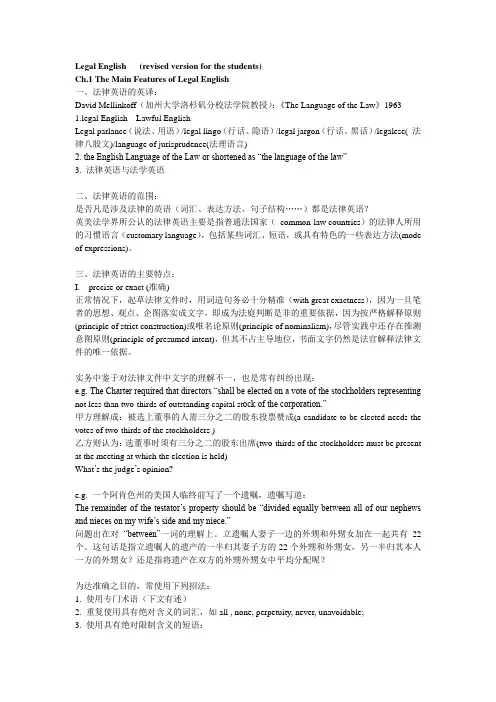
Legal English (revised version for the students)Ch.1 The Main Features of Legal English一、法律英语的英译:David Mellinkoff(加州大学洛杉矶分校法学院教授):《The Language of the Law》19631.legal English---Lawful EnglishLegal parlance(说法、用语)/legal lingo(行话、隐语)/legal jargon(行话、黑话)/legalese( 法律八股文)/language of jurisprudence(法理语言)2. the English Language of the Law or shortened as “the language of the law”3. 法律英语与法学英语二、法律英语的范围:是否凡是涉及法律的英语(词汇、表达方法、句子结构……)都是法律英语?英美法学界所公认的法律英语主要是指普通法国家(common-law countries)的法律人所用的习惯语言(customary language),包括某些词汇、短语,或具有特色的一些表达方法(mode of expressions)。
三、法律英语的主要特点:I. precise or exact (准确)正常情况下,起草法律文件时,用词造句务必十分精准(with great exactness),因为一旦笔者的思想、观点、企图落实成文字,即成为法庭判断是非的重要依据,因为按严格解释原则(principle of strict construction)或唯名论原则(principle of nominalism),尽管实践中还存在推测意图原则(principle of presumed intent),但其不占主导地位,书面文字仍然是法官解释法律文件的唯一依据。
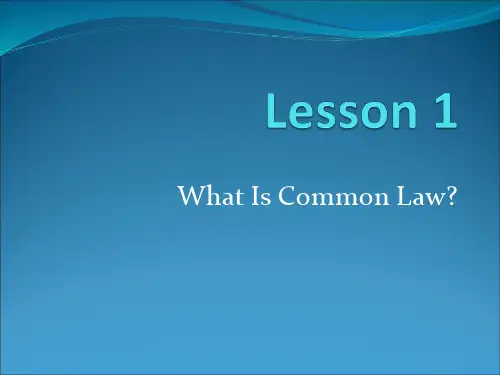
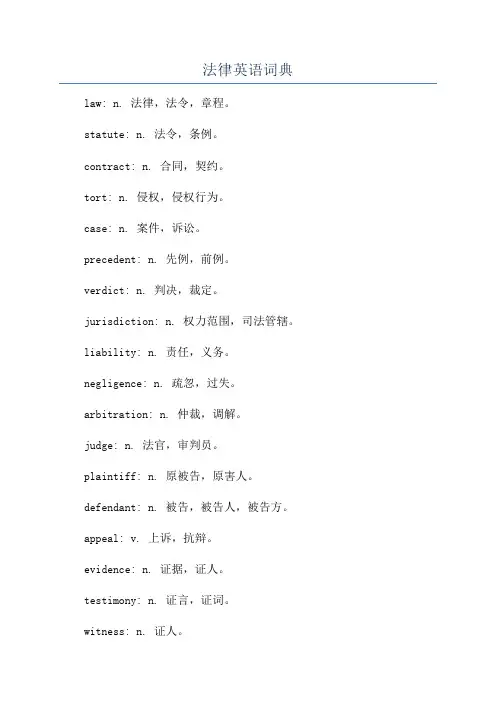
法律英语词典law: n. 法律,法令,章程。
statute: n. 法令,条例。
contract: n. 合同,契约。
tort: n. 侵权,侵权行为。
case: n. 案件,诉讼。
precedent: n. 先例,前例。
verdict: n. 判决,裁定。
jurisdiction: n. 权力范围,司法管辖。
liability: n. 责任,义务。
negligence: n. 疏忽,过失。
arbitration: n. 仲裁,调解。
judge: n. 法官,审判员。
plaintiff: n. 原被告,原害人。
defendant: n. 被告,被告人,被告方。
appeal: v. 上诉,抗辩。
evidence: n. 证据,证人。
testimony: n. 证言,证词。
witness: n. 证人。
adjudicate: v. 审判,判决。
jury: n. 陪审团。
court: n. 法院,庭。
lawsuit: n. 一案,官司。
prosecution: n. 控告,公诉。
docket: n. 案卷,审判案卷。
declaration: n. 声明,宣言。
lawyer: n. 律师,法律顾问。
counsel: n. 辩护律师。
bond: n. 缔约,保证。
sentence: n. 判决,宣判。
writ: n. 法院令。
litigation: n. 诉讼,诉讼行为。
appellate: v. 上诉,抗辩。
damage: n. 损害,损失。
asset: n. 财产,财务资产。
insurance: n. 保险。
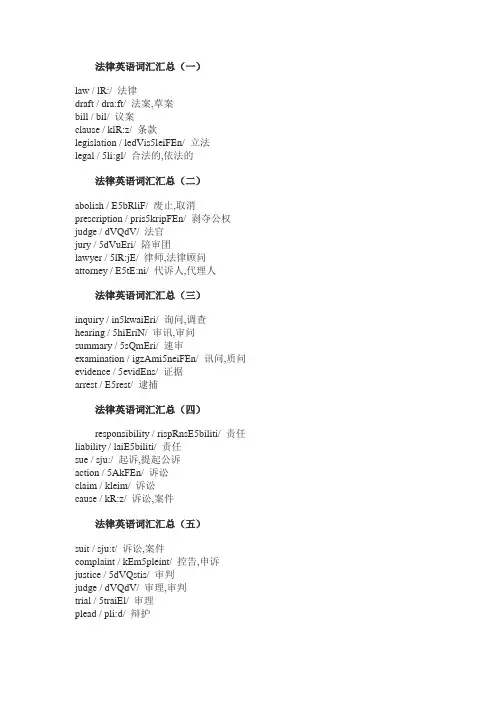
law / lR:/ 法律draft / dra:ft/ 法案,草案bill / bil/ 议案clause / klR:z/ 条款legislation / ledVis5leiFEn/ 立法legal / 5li:gl/ 合法的,依法的法律英语词汇汇总(二)abolish / E5bRliF/ 废止,取消prescription / pris5kripFEn/ 剥夺公权judge / dVQdV/ 法官jury / 5dVuEri/ 陪审团lawyer / 5lR:jE/ 律师,法律顾问attorney / E5tE:ni/ 代诉人,代理人法律英语词汇汇总(三)inquiry / in5kwaiEri/ 询问,调查hearing / 5hiEriN/ 审讯,审问summary / 5sQmEri/ 速审examination / igzAmi5neiFEn/ 讯问,质问evidence / 5evidEns/ 证据arrest / E5rest/ 逮捕法律英语词汇汇总(四)responsibility / rispRnsE5biliti/ 责任liability / laiE5biliti/ 责任sue / sju:/ 起诉,提起公诉action / 5AkFEn/ 诉讼claim / kleim/ 诉讼cause / kR:z/ 诉讼,案件法律英语词汇汇总(五)suit / sju:t/ 诉讼,案件complaint / kEm5pleint/ 控告,申诉justice / 5dVQstis/ 审判judge / dVQdV/ 审理,审判trial / 5traiEl/ 审理plead / pli:d/ 辩护claim / kleim/ 辩护plea / pli:/ 辩护evidence / 5evidEns/ 证词charge / tFa:dV/ 公诉书,刑事起诉书proof / pru:f/ 证据,证词evidence / 5evidEns/ 证据,证词法律英语词汇汇总(七)dock / dRk/ 被告席sentence / 5sentEns/ 宣判,判决convict / kEn5vikt, 5kRnvikt/ 囚犯,罪犯appeal / E5pi:l/ 上诉crime / kraim/ 犯法offence / E5fens/ 违法(美作:offense)法律英语词汇汇总(八)criminal / 5kriminl/ 罪犯attempt / E5tempt/ 未遂罪threat / Wret/ 恐吓menace / 5menEs/ 恐吓murder / 5mE:dE/ 暗杀,行刺plot / plRt/ 结伙阴谋,共谋法律英语词汇汇总(九)theft / Weft/ 盗窃fraud / frR:d/ 欺诈penalty / 5penlti/ 处罚prison / 5prizn/ 监狱(美作:jail)prisoner / 5priznE/ 囚犯gaol / dVeil/ 监狱(美作:jail)fine / fain/ 罚款法律英语词汇汇总(十)allowance / E5lauEns/ 抚养费heir / ZE/ 继承人lease / li:s/ 租约tutor / 5tju:tE/ 监护人transfer / trAns5fE:/ 转让guardian / 5ga:djEn/ 监护人assignment / E5sainmEnt/ 转让file / fail/ 文件will / wil/ 遗嘱地方人民检察院Local People's Procuratorate毒品罪narcotic drug crime二审法院Court of Second Instance发回重审remand a lawsuit for a new trial调解书mediation agreement法律law蠟♀筆♂小新2008-08-21 16:40基层人民法院basic People’s Court羁押期限term in custody级别管辖subject matter jurisdiction of courts at different levels监视居住living at home under surveillance监狱prison检察官procurator检察权prosecutorial power检察委员会procuratorial/prosecutorial committee检察院procuratorate检察院派出机构outpost tribunal of procuratorate简易程序summary procedure鉴定结论expert conclusion经济审判庭economic tribunal径行判决direct adjudication without sessions; judgement without notice 纠问式诉讼inquisitional proceedings拘传summon by force; summon by warrant拘留所detention house举报information/report of an offence举证责任burden of proof; onus probandi决定书decision军事法院military procuratorate开庭审理open a court session开庭通知notice of court session勘验笔录record of inquest看守所detention house可执行财产executable property控告式诉讼accusatory proceedings控诉证据incriminating evidence控诉职能accusation function扣押distrain on; attachment扣押物distress/distraint宽限期period of grace劳动争议仲裁申请书petition for labor dispute arbitration劳改场reform-through-labor farm劳教所reeducation-through-labor office类推判决的核准程序procedure for examination and approval of analogical sentence累积证据cumulative evidence立案报告place a case on file立案管辖functional jurisdiction立案决定书written decision of case-filing立案侦查report of placing a case on file利害关系人interested party临时裁决书interim award律师见证书lawyer’s written attestation; lawyer’s written authentication律师事务所law office; law firm律师提前介入prior intervention by lawyer免于刑事处分exemption from criminal penalty民事案件civil case民事审判庭civil tribunal民事诉讼civil action民事诉讼法Civil Procedural Law扭送seize and deliver a suspect to the police盗窃枪支crime of stealing firearms and ammunition盗窃武器装备theft of military equipment道真仡佬族苗族自治县Daozheng Mulao Nationality Autonomous County 得到证实to be believed得利者beneficiary抵触contravene抵押mortgage抵押品pledge抵押物mortgage地方人民检察院Local People's Procuratorate地役权easement第二审判庭second tribunal第三者the third party第一审判庭first tribunal典当物pledge调查investigation调查报告investigation调查取证investigate and collect evidence调解mediate调解和强制措施mediation and enforcement measure调解书mediation agreement调解书字号Written Mediation No.订货合同卡片 a card of contract订立formation定案结论verdict定案理由reason for decision定金deposit定期减免所得税regular reduction of income tax定性determination on the nature丢弃waive东北人民政府Northeast People's Government东乡族自治县Dongxiang Nationality Autonomous County 董事会board of directors动机intention, motive冻干健康人血浆frozen dry healthy human blood冻干血浆frozen dry blood plasma冻结freeze, suspend都安瑶族自治县Duan Yao Nationality Autonomous County毒品罪narcotic drug crime渎职罪crime of dereliction of duty独立的不法行为independent wrong独立个案individual cases独立核算工业企业independent accounting unit独立请求书independent claim独立审判independent adjudication断绝cease提出具体意见submit detailed opinions on对等原则principle of reciprocity对等原则并参照国际惯例the principle of reciprocity and in reference to the international practice对合同词句应当按照事情是有效的而不是无效的来理解verba ita sunt intelligenda ut res magis valeat guam pareat对金钱借贷的规定regulations of money lending对滥用职权的法律补救legal remedy for abuses of power对立的一方opposite party对令状的发出作确认acknowledge the issue of the writ对上诉抗辩oppose an appeal对书面文件的词句应当按照对提出词句的当事人尤为不利的原则来解释verba chartarum fortius accipiuntur contra proferentem对外经济法律顾问处Foreign Economic Legal Consultancy Office对外经济律师事务所foreign trade law firm对外经济贸易仲裁委员会Foreign Economic and Trade Arbitration Commission对外贸易经济合作部Ministry of Foreign Trade and Economic对物诉讼令状writ in rem对帐reconcile, reconciliation多边公约multilateral convention多边国际公约multi-latreal international conventions多分 a larger share多头long position, bull position多头仲裁multiple arbitration多于一名人士 2 or more persons多元立法体制plural legislative structure多元主义pluralism峨边彝族自治县Ebian Yi Nationality Autonomous County恩施土家族苗族自治县Enshi Tujia Nationality Miao Nationality Autonomous County恩恤付款ex gratia payment二审second instance二审裁定书order of second instance二审法院Court of Second Instance二审判决书written order of Second Instance二者只能择其一the inclusion of one is the exclusion of the other发回重审remand a lawsuit for a new trial发货人consignor, shipper发生法律效力be legally effective发现discovery发行审核委员会the Issuance Examination Commission发展规划development planLesson Two Legal Profession1. 法律职业/律师职业the bar法官职业the bench2. 律师协会 The Bar Association3. (律师)执业 practice law4. 执业律师 practicing lawyer5. 出庭辩护/代理诉讼advocacy6. 法律咨询 counselling7. 法律文件的起草drafting of legal instruments8. 法律文件legal instruments9. 单独执业者single/individual practitionre10. 合伙关系partnership11. 薪水律师 salaried lawyer12. 律师业务law practice13. 专职法律顾问 house counsel/corporate counsel(公司或团体法律顾问)14.辩护人/律师advocate15. 私人开业 private practice16. 州检察官/律师 state prosecutor/state attorney17. 地区检察官/律师 district attorney18. 起诉检察官/公诉律师prosecuting attorney19. 检察系统prosecutorial system20. 联邦检察官federal prosecutor21. 地方检察官local prosecutor22. 助理检察官assistant prosecutor23. 检察行业 prosecutorial profession24. 个人尊严the integrity of the individual25. 机会均等equality of opportunity26. 职业道德规范ethics codes27. 听证会hearings28. 社区法律服务community legal services29. 单人开业solo practice30. 律师/法律工作者attorney/attorney-at-law/counsellor/counsellor-at -law31. 律师(英国) barrister/solicitor1. 法律博士 Juris Doctor(JD)我国现称“法律硕士”并有新名“Juris Master(JM)2. 法学硕士 Master of Laws(LLM)3. 法学博士 Doctor of Juridical Science(SJD)4. 法律文书写作 legal writing5. 批评性思维 critical thinking6. 案例教学法 case method7. 苏格拉底式教学法 socratic method8. 讲演式教学法lecture method9. 美国律师协会认可的法学院 ABA accredited law schools10. 案情摘要briefs11. 模拟法庭 moot court12. 模拟审判 mock trial13. 课程指南 curriculum guide14. 刑事司法 criminal justice15. 自由资本主义 laissez faireLesson One Legal System1. 公诉制度 public prosecution2. 普通法系 common law legal system3. 判例法case law4. 成文法(制定法) written law (statutory law)5. 遵从前例 stare decisis6. 判例汇编 reports7. 有约束力的法律解释binding interpretation8. 法学方法论 legal methodology9. 颁布•••为法律be decreed10. 巡回法官itinerant judges11. 英国皇家法院 English Royal Court12. 令状,法院令状writ13. 诉讼请求的强制执行 enforcement of a claim14. 追诉权 recourse15. 牛津条例Provision of Oxford16. 本案令状writ upon the case17. 诉讼行为forms of action18. 衡平法 equity law19. 公平且善良 ex aequo bono20. 特定履行(实际履行)方式之救济relief in the form of specific performance21. 大法官法院 Court of Chancery22. 补偿性损害赔偿金 compensatory damages23. 强制令the injunction24. 衡平法准则 maxims of equity law25. 法律概念 legal concept26. 不动产real property/ real estate/ immovable property/ realty27. 民事诉讼 civil suit28. 衡平法院 Chancery Court29. 财产法上的所有权分割 division of title in the law of property30. 先例 precedents31. 普通法系the Common Law Legal Family/ the English Law Legal Family/ the English-American Law Legal Family32. 大陆法系 the Roman Law Legal Family/ the Civil Law Legal Family/ the Continental Law Legal Family33. 五月花号公约the Mayflower Compact34. 制宪会议 the Const itutional Convention。
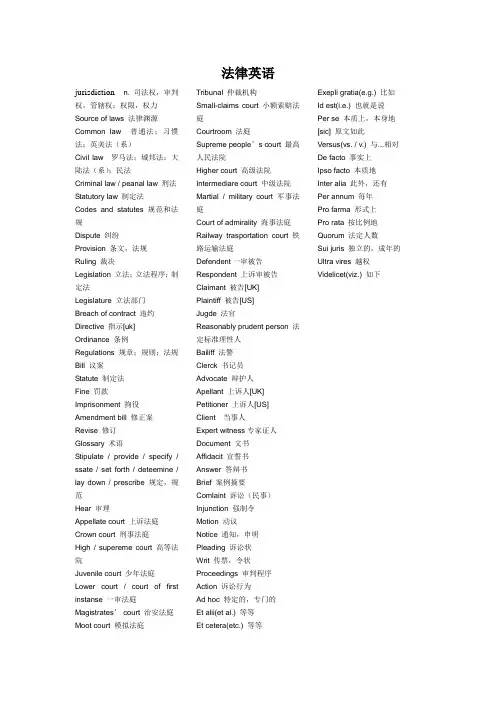
法律英语jurisdiction n. 司法权,审判权,管辖权;权限,权力Source of laws 法律渊源Common law 普通法;习惯法;英美法(系)Civil law 罗马法;城邦法;大陆法(系);民法Criminal law / peanal law 刑法Statutory law 制定法Codes and statutes 规范和法规Dispute 纠纷Provision 条文,法规Ruling 裁决Legislation 立法;立法程序;制定法Legislature 立法部门Breach of contract 违约Directive 指示[uk]Ordinance 条例Regulations 规章;规则;法规Bill 议案Statute 制定法Fine 罚款Imprisonment 拘役Amendment bill 修正案Revise 修订Glossary 术语Stipulate / provide / specify / ssate / set forth / deteemine / lay down / prescribe 规定,规范Hear 审理Appellate court 上诉法庭Crown court 刑事法庭High / supereme court 高等法院Juvenile court 少年法庭Lower court / court of first instanse 一审法庭Magistrates’ court 治安法庭Moot court 模拟法庭Tribunal 仲裁机构Small-claims court 小额索赔法庭Courtroom 法庭Supreme people’s court 最高人民法院Higher court 高级法院Intermediare court 中级法院Martial / military court 军事法庭Court of admirality 海事法庭Railway trasportation court 铁路运输法庭Defendent一审被告Respondent 上诉审被告Claimant 被告[UK]Plaintiff 被告[US]Jugde 法官Reasonably prudent person 法定标准理性人Bailiff 法警Clerck 书记员Advocate 辩护人Apellant 上诉人[UK]Petitioner 上诉人[US]Client 当事人Expert witness专家证人Document 文书Affidacit 宣誓书Answer 答辩书Brief 案例摘要Comlaint 诉讼(民事)Injunction 强制令Motion 动议Notice 通知,申明Pleading 诉讼状Writ 传票,令状Proceedings 审判程序Action 诉讼行为Ad hoc 特定的,专门的Et alii(et al.) 等等Et cetera(etc.) 等等Exepli gratia(e.g.) 比如Id est(i.e.) 也就是说Per se 本质上,本身地[sic] 原文如此Versus(vs. / v.) 与...相对De facto 事实上Ipso facto 本质地Inter alia 此外,还有Per annum 每年Pro farma 形式上Pro rata 按比例地Quorum 法定人数Sui juris 独立的,成年的Ultra vires 越权Videlicet(viz.) 如下。
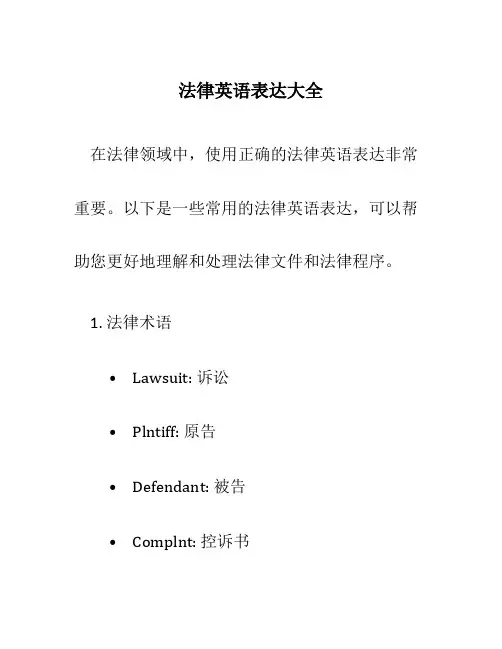
法律英语表达大全在法律领域中,使用正确的法律英语表达非常重要。
以下是一些常用的法律英语表达,可以帮助您更好地理解和处理法律文件和法律程序。
1. 法律术语•Lawsuit: 诉讼•Plntiff: 原告•Defendant: 被告•Complnt: 控诉书•Summons: 传票•Pleadings: 诉状•Subpoena: 传唤令•Evidence: 证据•Burden of proof: 举证责任•Statute: 法令•Tort: 民事侵权行为•Testimony: 证言•Criminal offense: 刑事犯罪•Misdemeanor: 轻罪•Felony: 重罪2. 法庭程序•Court hearing: 庭审•Trial: 审判•Opening statement: 开庭陈述•Cross-examination: 盘问•Closing argument: 闭庭陈述•Verdict: 裁决•Jury: 陪审团•Bench trial: 座席审判(没有陪审团的审判)•Judgment: 判决•Appeal: 上诉•Court reporter: 法庭记录员•Arrest: 逮捕•Bond: 保释金•Bl: 保释•Evidence: 证据3. 合同和协议•Contract: 合同•Agreement: 协议•Offer: 出价•Acceptance: 接受•Consideration: 对价•Breach of contract: 违反合同•Void contract: 无效合同•Negotiation: 谈判•Arbitration: 仲裁•Mediation: 调解•Termination: 终止•Amendment: 修改•Effective date: 生效日期4. 法律文件和法律文件结构•Legal document: 法律文件•Affidavit: 宣誓书•Power of attorney: 授权书•Will: 遗嘱•Trust: 信托•Deed: 契约•Contract: 合同•Agreement: 协议•Compliance: 遵守•Notice: 通知书•Affirmation: 证言•Declaration: 声明•Schedule: 时间表•Exhibit: 附表5. 法律职业•Attorney: 律师•Judge: 法官•Magistrate: 地方法官•Counsel: 律师•Paralegal: 法律助理•Legal secretary: 法律秘书•Legal consultant: 法律顾问•Court clerk: 法庭书记员•Barrister: 出庭律师(英国律师)•Solicitor: 执业律师(英国律师)以上是一些常用的法律英语表达。
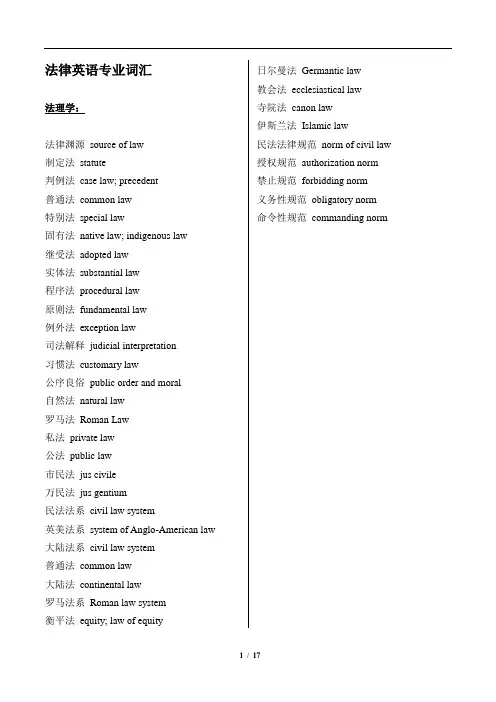
法律英语专业词汇法理学:法律渊源source of law制定法statute判例法case law; precedent普通法common law特别法special law固有法native law; indigenous law继受法adopted law实体法substantial law程序法procedural law原则法fundamental law例外法exception law司法解释judicial interpretation习惯法customary law公序良俗public order and moral自然法natural law罗马法Roman Law私法private law公法public law市民法jus civile万民法jus gentium民法法系civil law system英美法系system of Anglo-American law 大陆法系civil law system普通法common law大陆法continental law罗马法系Roman law system衡平法equity; law of equity 日尔曼法Germantic law教会法ecclesiastical law寺院法canon law伊斯兰法Islamic law民法法律规范norm of civil law 授权规范authorization norm禁止规范forbidding norm义务性规范obligatory norm命令性规范commanding norm民法:民法基本原则fundamental principles of civil law平等原则principle of equality自愿原则principle of free will公平原则principle of justice等价有偿原则principle of equal value exchange诚实信用原则principle of good faith行为act作为ac不作为omission合法行为lawful act 违法行为unlawful act民事权利权利能力civil right绝对权absolute right相对权relative right优先权right of priority先买权preemption原权antecedent right救济权right of relief支配权right of dominion请求权right of claim物上请求权right of claim for real thing 形成权right of formation撤销权right of claiming cancellation否认权right of claiming cancellation解除权right of renouncement代位权subrogated right选择权right of choice承认权right of admission终止权right of termination抗辩权right of defense一时性抗辩权momentary right of defense永久性抗辩权permanent counter-argument right不安抗辩权unstable counter-argument right 同时履行抗辩权defense right of simultaneous performance既得权tested right期待权expectant right专属权exclusive right非专属权non-exclusive right 人身权利personal right人权human right人格权right of personality生命健康权right of life and health 姓名权right of name名称权right of name肖像权right of portraiture自由权right of freedom名誉权right reputation隐私权right of privacy私生活秘密权right of privacy贞操权virginity right身份权right of status亲权parental power; parental right 亲属权right of relative探视权visitation right配偶权right of spouse荣誉权right of honor权利的保护protection of right公力救济public protection私力救济self-protection权利本位standard of right社会本位standard of society无责任行为irresponsible right正当防卫justifiable right; ligitimate defence 防卫行为act of defence自为行为self-conducting act紧急避险act of rescue; necessity自助行为act of self-help不可抗力force majeure意外事件accident行为能力capacity for act意思能力capacity of will民事行为civil act意思表示declaration of intention意思表示一致meeting of minds; consensus 完全行为能力perfect capacity for act限制行为能力restrictive capacity for act准禁治产人quasi-interdicted person保佐protection自治产人minor who is capable of administering his own capacity无行为能力incapacity for act禁治产人interdicted person自然人natural person公民citizen住所domicile居所residence 经常居住地frequently dwelling place户籍census register监护guardianship个体工商户individual business农村承包经营户leaseholding rural household 合伙partnership合伙人partner合伙协议partnership agreement合伙财产property of partnership合伙债务debt of partnership入伙join partnership退伙withdrawal from partnership合伙企业partnership business establishment 个人合伙partnership法人合伙partnership of legal person特别合伙special partnership普通合伙general partnership有限合伙limited partnership民事合伙civil partnership隐名合伙sleeping partnership; dormant partnership私营企业private enterprise; proprietorship法人legal person企业法人legal body of enterprise企业集团group of enterprise关联企业affiliate enterprise个人独资企业individual business establishment国有独资企业solely state-owned enterprise 中外合资企业Sino-foreign joint venture enterprise中外合作企业Sino-foreign contractual enterprise社团法人legal body of mass organization财团法人legal body of financial group联营joint venture法人型联营association of legal persons合伙型联营coordinated management in partnership协作型联营cooperation-type coordinated management合作社cooperative民事法律行为civil legal act单方民事法律行为unilateral civil legal act 双方民事法律行为bilateral civil legal act多方民事法律行为joint act civil legal act有偿民事法律行为civil legal act with consideration无偿民事法律行为civil legal act without consideration; civil legal act without award实践性民事法律行为practical civil legal act 法律翻译公司诺成性民事法律行为consental civil legal act 要式民事法律行为formal civil legal act不要式民事法律行为informal civil legal act 要因民事法律行为causative civil legal act 不要因民事法律行为noncausative civil legal act主民事法律行为principal civil legal act从民事法律行为accessory civil legal act附条件民事法律行为conditional civil legal act 附期限民事法律行为civil legal act with term 生前民事法律行为civil legal act before death 死后民事法律行为civil legal act after death 准民事法律行为quasi-civil legal act无效行为ineffective act可撤销民事行为revocable civil act违法行为illegal act; unlawful act侵权行为tort欺诈fraud胁迫duress乘人之危taking advantage of others’precarious position以合法形式掩盖非法目的legal form concealing illegal intention恶意串通malicious collaboration重大误解gross misunderstanding显失公平obvious unjust误传misrepresentation代理agency本人principal被代理人principal受托人trustee代理人agent本代理人original agent法定代理人statutory agent; legal agent委托代理人agent by mandate指定代理人designated agent复代理人subagent再代理人subagent转代理人subagent代理权right of agency授权行为act of authorization授权委托书power of attorney代理行为act of agency委托代理agency by mandate本代理original agency复代理subagency次代理subagency有权代理authorized agency表见代理agency by estoppel; apparent agency 律师代理agency by lawyer普通代理general agency全权代理general agency全权代理委托书general power of attorney共同代理joint agency独家代理sole agency居间brokerage居间人broker行纪commission; broker house信托trust时效time limit; prescription; limitation时效中止suspension of prescription/limitation 时效中断interruption oflimitation/prescription时效延长extension of limitation取得时效acquisitive prescription时效终止lapse of time; termination of prescription期日date期间term国际法:涉外民事关系civil relations with foreign elements冲突规范rule of conflict准据法applicable law; governing law反致renvoi; remission转致transmission识别identification公共秩序保留reserve of public order法律规避evasion of law国籍nationality国有化nationalization法律责任legal liability民事责任civil liability/responsibility行政责任administrative liability/responsibility 刑事责任criminal liability/responsibility违约责任liability of breach of contract; responsibility of default有限责任limited liability无限责任unlimited liability按份责任shared/several liability连带责任joint and several liability过失责任liability for negligence; negligent liability过错责任fault liability; liability for fault单独过错sole fault共同过错joint fault混合过错mixed fault被害人过错victim’s fault第三人过错third party’s fault 推定过错presumptive fault恶意bad faith; malice故意deliberate intention; intention; willfulness 过失negligence重大过失gross negligence疏忽大意的过失careless and inadvertent negligence过于自信的过失negligence with undue assumption损害事实facts of damage有形损失tangible damage/loss无形损失intangible damage/loss财产损失property damage/loss人身损失personal damage/loss精神损失spiritual damage/loss民事责任承担方式methods of bearing civil liability停止侵害cease the infringing act排除妨碍exclusion of hindrance; removal of obstacle消除危险elimination of danger返还财产restitution of property恢复原状restitution; restitution of original state赔偿损失compensate for a loss; indemnify for a loss支付违约金payment of liquidated damage消除影响eliminate ill effects恢复名誉rehabilitate one’s reputation赔礼道歉extend a formal apology。
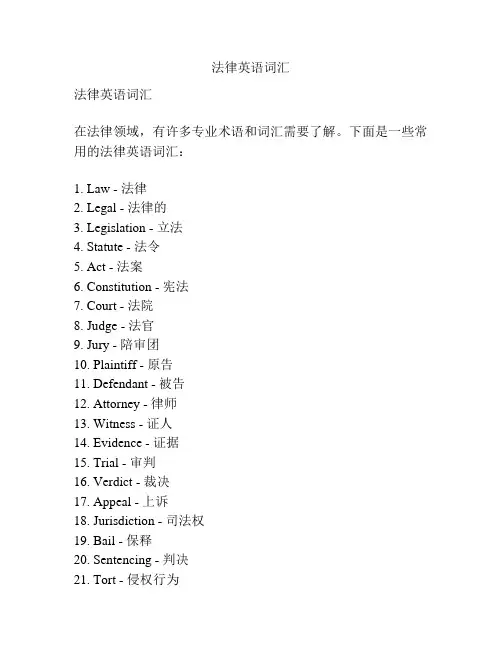
法律英语词汇法律英语词汇在法律领域,有许多专业术语和词汇需要了解。
下面是一些常用的法律英语词汇:1. Law - 法律2. Legal - 法律的3. Legislation - 立法4. Statute - 法令5. Act - 法案6. Constitution - 宪法7. Court - 法院8. Judge - 法官9. Jury - 陪审团10. Plaintiff - 原告11. Defendant - 被告12. Attorney - 律师13. Witness - 证人14. Evidence - 证据15. Trial - 审判16. Verdict - 裁决17. Appeal - 上诉18. Jurisdiction - 司法权19. Bail - 保释20. Sentencing - 判决21. Tort - 侵权行为22. Contract - 合同23. Breach - 违约24. Liability - 责任25. Damages - 赔偿金26. Negligence - 疏忽27. Fraud - 欺诈28. Property - 财产29. Estate - 房地产30. Will - 遗嘱31. Trust - 信托32. Patent - 专利33. Copyright - 版权34. Trademark - 商标35. Infringement - 侵权36. Bankruptcy - 破产37. Contractual - 合同的38. Criminal - 刑事的39. Civil - 民事的40. Administrative - 行政的41. Constitutional - 宪法的42. International - 国际的43. Liability - 责任44. Negligence - 疏忽45. Intentional - 故意的46. Due Process - 正当程序47. Jurisprudence - 法学48. Precedent - 先例49. Stare Decisis - 依据先例50. Habeas Corpus - 人身保护权51. Confidentiality - 保密性52. Dispute - 争端53. Injunction - 禁令54. Public - 公共的55. Private - 私人的56. Liability - 责任57. Malpractice - 不当行为58. Probate - 遗产审计59. Slander - 诽谤60. Libel - 诽谤罪61. Suing - 控告62. Settlement - 和解63. Restitution - 赔偿64. Breach of contract - 违约65. Act of God - 天灾66. Affidavit - 宣誓书67. Doctrines - 教条68. Breach of trust - 违背信任69. Jurisdiction - 司法权70. Lien - 留置权71. Remedy - 补救72. Statutes of limitations - 时效法73. Contempt - 蔑视74. Acquittal - 无罪释放75. Inadmissible - 不可采用的76. Null and void - 无效77. Alibi - 不在场证明78. Arraignment - 传讯79. Litigation - 诉讼80. Conviction - 有罪定罪81. Cross-examination - 盘问82. Defamation - 诽谤83. Inquest - 审讯84. Disbar - 剥夺执业权85. Extradition - 引渡86. Fiduciary - 受托人87. Indictment - 起诉书88. Plea - 奏折89. Pro bono - 免费律师90. Testimony - 证词91. Warrant - 法令92. Appeal - 上诉93. Bailiff - 安保人员94. Dismiss - 解雇95. Embezzlement - 盗窃罪96. Forfeit - 剥夺97. Injunction - 禁制令98. Mitigating - 降低99. Notary - 公证人100. Tortfeasor - 侵权者以上是一些常见的法律英语词汇,希望对您有所帮助!。
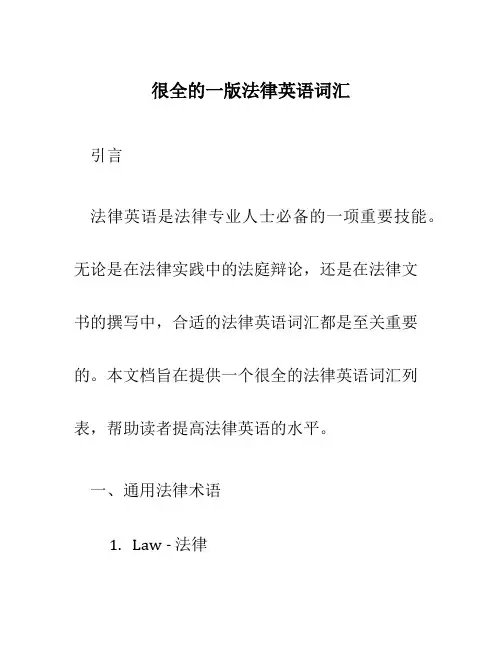
很全的一版法律英语词汇引言法律英语是法律专业人士必备的一项重要技能。
无论是在法律实践中的法庭辩论,还是在法律文书的撰写中,合适的法律英语词汇都是至关重要的。
本文档旨在提供一个很全的法律英语词汇列表,帮助读者提高法律英语的水平。
一、通用法律术语w - 法律2.Legislation - 法规3.Statute - 法令4.Regulation - 规章5.Act - 法案6.Case - 案例7.Jurisdiction - 管辖权8.Court - 法院9.Judge - 法官10.A ttorney - 律师11.D efendant - 被告12.P lntiff - 原告13.W itness - 证人14.E vidence - 证据15.V erdict - 裁决二、合同法1.Contract - 合同2.Offer - 出价3.Acceptance - 接受4.Consideration - 对价5.Breach - 违约6.Performance - 履行7.Damages - 损害赔偿8.Termination - 终止9.Agreement - 协议10.C ounteroffer -还盘三、刑法1.Crime - 犯罪2.Offense - 违法行为3.Murder - 谋杀4.Robbery - 抢劫5.Theft - 盗窃6.Assault - 袭击7.Fraud - 欺诈8.Sentence - 判决9.Conviction - 定罪10.G uilty - 有罪11.I nnocent - 无罪四、知识产权法1.Copyright - 版权2.Trademark - 商标3.Patent - 专利4.Infringement - 侵权5.Intellectual Property - 知识产权6.License - 许可证7.Royalty - 版税8.Invention - 发明9.Trade Secret - 商业秘密10.F r Use - 合理使用五、公司法pany - 公司2.Shareholder - 股东3.Director - 董事4.Merger - 合并5.Acquisition - 收购6.Incorporation - 注册成立7.Bylaws - 法规章程8.Share - 股份9.Dividend - 红利10.B oard of Directors - 董事会六、劳动法1.Employment - 就业2.Employee - 员工3.Employer - 雇主4.Discrimination - 歧视5.Overtime - 加班6.Termination - 解雇7.Retaliation - 报复8.Worker’s Compensation - 工伤赔偿9.Collective Bargning - 集体协商10.M inimum Wage - 最低工资结论以上展示了一个很全的法律英语词汇列表,覆盖了通用法律术语以及一些常见的法律领域术语。
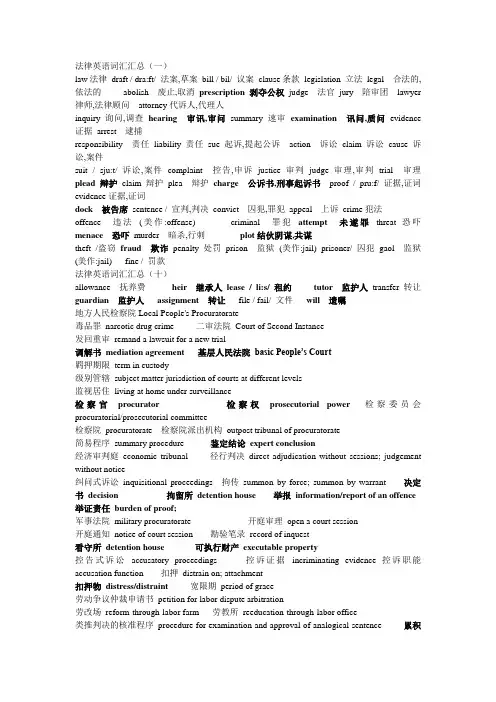
法律英语词汇汇总(一)law法律draft / dra:ft/ 法案,草案bill / bil/ 议案clause条款legislation 立法legal 合法的,依法的abolish 废止,取消prescription剥夺公权judge 法官jury 陪审团lawyer 律师,法律顾问attorney代诉人,代理人inquiry 询问,调查hearing 审讯,审问summary速审examination 讯问,质问evidence 证据arrest 逮捕responsibility 责任liability 责任sue 起诉,提起公诉action 诉讼claim 诉讼cause 诉讼,案件suit / sju:t/ 诉讼,案件complaint 控告,申诉justice审判judge 审理,审判trial 审理plead辩护claim 辩护plea 辩护charge 公诉书,刑事起诉书proof / pru:f/ 证据,证词evidence证据,证词dock 被告席sentence / 宣判,判决convict 囚犯,罪犯appeal 上诉crime犯法offence 违法(美作:offense) criminal 罪犯attempt 未遂罪threat 恐吓menace 恐吓murder 暗杀,行刺plot结伙阴谋,共谋theft /盗窃fraud 欺诈penalty处罚prison 监狱(美作:jail) prisoner/ 囚犯gaol 监狱(美作:jail) fine / 罚款法律英语词汇汇总(十)allowance 抚养费heir 继承人lease / li:s/ 租约tutor 监护人transfer转让guardian 监护人assignment 转让file / fail/ 文件will 遗嘱地方人民检察院Local People's Procuratorate毒品罪narcotic drug crime 二审法院Court of Second Instance发回重审remand a lawsuit for a new trial调解书mediation agreement 基层人民法院basic People’s Court羁押期限term in custody级别管辖subject matter jurisdiction of courts at different levels监视居住living at home under surveillance检察官procurator检察权prosecutorial power检察委员会procuratorial/prosecutorial committee检察院procuratorate 检察院派出机构outpost tribunal of procuratorate简易程序summary procedure 鉴定结论expert conclusion经济审判庭economic tribunal 径行判决direct adjudication without sessions; judgement without notice纠问式诉讼inquisitional proceedings 拘传summon by force; summon by warrant 决定书decision拘留所detention house 举报information/report of an offence 举证责任burden of proof;军事法院military procuratorate 开庭审理open a court session开庭通知notice of court session 勘验笔录record of inquest看守所detention house可执行财产executable property控告式诉讼accusatory proceedings 控诉证据incriminating evidence控诉职能accusation function 扣押distrain on; attachment扣押物distress/distraint 宽限期period of grace劳动争议仲裁申请书petition for labor dispute arbitration劳改场reform-through-labor farm 劳教所reeducation-through-labor office类推判决的核准程序procedure for examination and approval of analogical sentence 累积证据cumulative evidence立案报告place a case on file 立案管辖functional jurisdiction立案决定书written decision of case-filing立案侦查report of placing a case on file 利害关系人interested party临时裁决书interim award律师见证书lawyer’s written attestation; lawyer’s written authentication 律师事务所law office; law firm律师提前介入prior intervention by lawyer免于刑事处分exemption from criminal penalty民事案件civil case民事审判庭civil tribunal民事诉讼civil action民事诉讼法Civil Procedural Law扭送seize and deliver a suspect to the police盗窃枪支crime of stealing firearms and ammunition盗窃武器装备theft of military equipment 得到证实to be believe得利者beneficiary 抵触contravene 抵押mortgage 抵押品、典当物pledge 抵押物mortgage 地方人民检察院Local People's Procuratorate地役权easement第二审判庭second tribunal 第三者the third party第一审判庭first tribunal调查investige 调查报告investigation调查取证investigate and collect evidence 调解mediate调解和强制措施mediation and enforcement measure 调解书mediation agreement调解书字号Written Mediation No. 订货合同卡片a card of contract订立formation定案结论verdict 定案理由reason for decision定金deposit定期减免所得税regular reduction of income tax定性determination on the nature丢弃waive董事会board of directors 动机intention, motive 冻结freeze, suspend毒品罪narcotic drug crime 渎职罪crime of dereliction of duty独立的不法行为independent wrong 独立个案individual cases独立核算工业企业independent accounting unit独立请求书independent claim 独立审判independent adjudication断绝cease 提出具体意见submit detailed opinions on对等原则principle of reciprocity对等原则并参照国际惯例the principle of reciprocity and in reference to the international practice对合同词句应当按照事情是有效的而不是无效的来理解verba ita sunt intelligenda ut res magis valeat guam pareat对金钱借贷的规定regulations of money lending对滥用职权的法律补救legal remedy for abuses of power对立的一方opposite party对令状的发出作确认acknowledge the issue of the writ对上诉抗辩oppose an appeal对书面文件的词句应当按照对提出词句的当事人尤为不利的原则来解释verba chartarumfortius accipiuntur contra proferentem对外经济法律顾问处Foreign Economic Legal Consultancy Office对外经济律师事务所foreign trade law firm对外经济贸易仲裁委员会Foreign Economic and Trade Arbitration Commission对外贸易经济合作部Ministry of Foreign Trade and Economic对物诉讼令状writ in rem对帐reconcile, reconciliation 多边公约multilateral convention多边国际公约multi-latreal international conventions 多分 a larger share 多头long position, bull position多头仲裁multiple arbitration 多元立法体制plural legislative structure 多元主义pluralism二审second instance 二审裁定书order of second instance二审法院Court of Second Instance 二审判决书written order of Second Instance二者只能择其一the inclusion of one is the exclusion of the other发回重审remand a lawsuit for a new trial 发货人consignor, shipper发生法律效力be legally effective发现discovery发行审核委员会the Issuance Examination Commission 发展规划development plan Lesson Two Legal Profession1. 法律职业/律师职业 the bar 法官职业 the bench2. 律师协会 The Bar Association3. (律师)执业 practice law4. 执业律师 practicing lawyer5. 出庭辩护/代理诉讼 advocacy6. 法律咨询 counselling7. 法律文件的起草 drafting of legal instruments8. 法律文件 legal instruments9. 单独执业者 single/individual practitionre 10. 合伙关系 partnership 11. 薪水律师 salaried lawyer12. 律师业务 law practice13. 专职法律顾问 house counsel/corporate counsel(公司或团体法律顾问)14.辩护人/律师advocate 15. 私人开业 private practice16. 州检察官/律师 state prosecutor/state attorney 17. 地区检察官/律师 district attorney18. 起诉检察官/公诉律师 prosecuting attorney 19. 检察系统prosecutorial system20. 联邦检察官 federal prosecutor 21. 地方检察官 local prosecutor22. 助理检察官 assistant prosecutor 23. 检察行业 prosecutorial profession24. 个人尊严the integrity of the individual 25. 机会均等 equality of opportunity 26. 职业道德规范ethics codes 27. 听证会 hearings28. 社区法律服务 community legal services 29. 单人开业solo practice30. 律师/法律工作者attorney/attorney-at-law/counsellor/counsellor-at-law31. 律师(英国) barrister/solicitor1. 法律博士 Juris Doctor(JD) 我国现称“法律硕士”并有新名“Juris Master(JM)2. 法学硕士 Master of Laws(LLM)3. 法学博士 Doctor of Juridical Science(SJD)4. 法律文书写作 legal writing5. 批评性思维critical thinking6. 案例教学法 case method7. 苏格拉底式教学法 socratic method 8. 讲演式教学法 lecture method9. 美国律师协会认可的法学院ABA accredited law schools 10. 案情摘要briefs 11. 模拟法庭 moot court12. 模拟审判 mock trial 13. 课程指南curriculum guide14. 刑事司法 criminal justice 15. 自由资本主义 laissez faireLesson One Legal System1. 公诉制度 public prosecution . 普通法系common law legal system3. 判例法case law4. 成文法(制定法)written law (statutory law)5. 遵从前例 stare decisis6. 判例汇编 reports7. 有约束力的法律解释binding interpretation8. 法学方法论 legal methodology9. 颁布•••为法律be decreed 12. 令状,法院令状 writ13. 诉讼请求的强制执行 enforcement of a claim 14. 追诉权 recourse15. 牛津条例Provision of Oxford 16. 本案令状 writ upon the case 17. 诉讼行为 forms of action 18. 衡平法equity law20. 特定履行(实际履行)方式之救济relief in the form of specific performance21. 大法官法院 Court of Chancery 22. 补偿性损害赔偿金compensatory damages23. 强制令the injunction 24. 衡平法准则 maxims of equity law25. 法律概念legal concept 30. 先例 precedents26. 不动产 real property/ real estate/ immovable property/ realty27.民事诉讼 civil suit 28. 衡平法院 Chancery Court29. 财产法上的所有权分割 division of title in the law of property31. 普通法系 the Common Law Legal Family/ the English Law Legal Family/ the English-American Law Legal Family32. 大陆法系 the Roman Law Legal Family/ the Civil Law Legal Family/ the Continental Law Legal Family 34. 制宪会议the Constitutional Convention10年一、名词解释(9*5=45’)危害行为、拘役、犯罪预备、人格权、担保物权、代理、司法、实体法、法定解释二、简答(6*10=60’)1民事法律行为;2中国特色社会主义法律体系;3间接故意与过于自信的区别;4法律作用的局限性;5减刑与减轻的区别;6缔约过失责任三、论述(3*15=45’)1从法理的角度谈谈中国出现的“重庆打黑”现象;2共同犯罪人的种类以及处罚原则;3为什么说平等原则是民法的基本原则09名词解释:1.法的适用;2.表见代理3.共同犯罪;4.缓刑的概念;5.诉讼时效;简答:1。
法律英语词汇大全(完美版)一、基本法律词汇1. 法律(Law):国家制定或认可的,用以规范社会成员行为、调整社会关系的规范总称。
2. 法规(Regulation):国家行政机关根据法律制定的具有普遍约束力的规范性文件。
3. 条款(Clause):法律、合同等文件中的具体规定。
4. 判决(Judgment):法院对案件审理后作出的结论性意见。
5. 律师(Lawyer):依法取得执业资格,为社会提供法律服务的专业人员。
6. 诉讼(Lawsuit):当事人依法向法院提起的请求保护自己合法权益的程序。
二、刑法相关词汇1. 犯罪(Crime):违反刑法规定,危害社会,依法应受刑罚处罚的行为。
2. 罪名(Charge):对犯罪嫌疑人指控的具体犯罪名称。
3. 刑罚(Punishment):国家对犯罪分子实行的一种强制措施,包括主刑和附加刑。
4. 刑事责任(Criminal Responsibility):犯罪分子因其犯罪行为所应承担的法律责任。
5. 量刑(Sentencing):法院根据犯罪分子的犯罪事实、情节和悔罪表现,依法决定刑罚的种类和幅度。
三、民法相关词汇1. 合同(Contract):当事人之间设立、变更、终止民事法律关系的协议。
2. 权利(Right):法律赋予当事人实现某种利益的可能性。
3. 义务(Obligation):当事人依法应承担的责任。
4. 赔偿(Compensation):因侵权行为给他人造成损失,依法应承担的经济补偿责任。
5. 继承(Inheritance):继承人依法取得被继承人遗产的法律制度。
四、商法相关词汇1. 公司(Company):依法设立的,以营利为目的的企业法人。
2. 股东(Shareholder):持有公司股份,享有公司权益和承担公司风险的人。
3. 破产(Bankruptcy):债务人因不能清偿到期债务,经法院宣告破产,对其财产进行清算的法律程序。
4. 票据(Bill):具有一定格式,载明一定金额,由出票人签发,无条件支付给持票人或指定人的有价证券。
法律渊源source of law制定法statute判例法case law; precede nt 普通法com mon law 特别法special law固有法native law; indigenous law 继受法adopted law 实体法substantial law 程序法procedural law 原贝U法fun dame ntal law 例外法exception law 司法解释judicial interpretation 习惯法customary law 公序良俗public order and moral 自然法natural law 罗马法Roman Law 私法private law 公法public law 市民法jus civile 万民法jus gentium 民法法系civil law system 英美法系system of Anglo-American law 大陆法系civil law system 普通法com mon law 大陆法continental law 罗马法系Roman law system 衡平法equity; law of equity 日尔曼法Germantic law 教会法ecclesiastical law 寺院法canon law 伊斯兰法Islamic law民法法律规范norm of civil law 授权规范authorization norm 禁止规范forbidding norm 义务性规范obligatory norm 命令性规范commanding norm民法基本原贝U fun dame ntal prin ciples of civil law平等原贝U principle of equality 自愿原贝U principle of free will 公平原贝U principle of justice 等价有偿原贝U prin ciple of equal value exchange诚实信用原贝U prin ciple of good faith 行为act 作为ac不作为omission合法行为lawful act违法行为unlawful act民事权利权利能力civil right 绝对权absolute right 相对权relative right 优先权right of priority 先买权preemption 原权antecedent right 救济权right of relief 支配权right of dominion 请求权right of claim 物上请求权right of claim for real thing 形成权right of formation 撤销权right of claiming cancellation否认权right of claiming cancellation解除权right of renouncement代位权subrogated right选择权right of choice承认权right of admission终止权right of term in ati on抗辩权right of defense一时性抗辩权mome ntary right of defense 永久性抗辩权perma nent coun ter-argume nt right 不安抗辩权unstable counter-argument right 同时履行抗辩权defense right of simulta neous performa nee既得权tested right期待权expectant right专属权exclusive right非专属权non-exclusive right人身权禾personal right人权human right人格权right of personality生命健康权right of life and health姓名权right of name名称权right of name肖像权right of portraiture自由权right of freedom名誉权right reputation隐私权right of privacy私生活秘密权right of privacy贞操权virginity right身份权right of status亲权parental power; parental right 亲属权right of relative 探视权visitation right 酉己偶权right of spouse 荣誉权right of honor 权利的保护protection of right 公力救济public protection 私力救济self-protect ion 权禾本位standard of right 社会本位standard of society 无责任行为irresponsible right 正当防卫justifiable right; ligitimate defence 防卫行为act of defence 自为行为self-conducting act 紧急避险act of rescue; necessity 自助行为act of self-help 不可抗力force majeure 意外事件accident 行为能力capacity for act 意思能力capacity of will 民事行为civil act 意思表示declaration of intention 意思表示一致meet ing of min ds; consen sus 完全行为能力perfect capacity for act 限制行为能力restrictive capacity for act 准禁治产人quasi-interdicted person 保佐protection自治产人minor who is capable of admi nisteri ng his own capacity 无行为能力in capacity for act 禁治产人interdicted person 自然人natural person公民citizen住所domicile居所reside nee经常居住地frequently dwelling place户籍census register监护guardianship个体工商户in dividual bus in ess农村承包经营户leasehold ing rural household 合伙partnership合伙人partner合伙协议partnership agreement合伙财产property of partnership合伙债务debt of partnership入伙join partnership退伙withdrawal from partnership合伙企业part nership bus in ess establishme nt 个人合伙partnership法人合伙partnership of legal person特别合伙special partnership普通合伙general partnership有限合伙limited partnership民事合伙civil partnership隐名合伙sleeping partnership; dormantpart nership私营企业private enterprise; proprietorship 法人legal person企业法人legal body of enterprise企业集团group of enterprise关联企业affiliate enterprise个人独资企业in dividual bus in ess establishme nt国有独资企业solely state-ow ned en terprise 中外合资企业Si no-foreig n joi nt ven ture en terprise中外合作企业Si no-foreig n con tractualen terprise社团法人legal body of mass organization 财团法人legal body of financial group 联营joint venture法人型联营association of legal persons 合伙型联营coordinated management in part nership 协作型联营cooperati on-type coord in ated man ageme nt合作社cooperative民事法律行为civil legal act 单方民事法律行为uni lateral civil legal act 双方民事法律行为bilateral civil legal act 多方民事法律行为joi nt act civil legal act 有偿民事法律行为civil legal act with con siderati on无偿民事法律行为civil legal act without con siderati on; civil legal act without award 实践性民事法律行为practical civil legal act法律翻译公司诺成性民事法律行为consen tal civil legal act要式民事法律行为formal civil legal act 不要式民事法律行为in formal civil legal act 要因民事法律行为causative civil legal act 不要因民事法律行为non causative civil legal act主民事法律行为prin cipal civil legal act从民事法律行为accessory civil legal act 附条件民事法律行为con diti on al civil legalact附期限民事法律行为civil legal act with term生前民事法律行为civil legal act before death 死后民事法律行为civil legal act after death 准民事法律行为quasi-civil legal act 无效行为in effective act可撤销民事行为revocable civil act违法行为illegal act; unlawful act侵权行为tort欺诈fraud胁迫duress乘人之危taking advantage of others precarious positi on以合法形式掩盖非法目的legal formcon ceali ng illegal inten ti on恶意串通malicious collaboration重大误解gross misunderstanding显失公平obvious unjust误传misrepresentation代理agency本人principal被代理人principal受托人trustee代理人age nt本代理人orig inal age nt法定代理人statutory age nt; legal age nt委托代理人age nt by man date指定代理人desig nated age nt复代理人subage nt再代理人subage nt 转代理人subage nt 代理权right of agency 授权行为act of authorization 授权委托书power of attorney 代理行为act of agency 委托代理age ncy by man date 本代理original agency 复代理subagency 次代理subagency 有权代理authorized agency 表见代理agency by estoppel; apparent agency 律师代理agency by lawyer 普通代理general agency 全权代理general agency全权代理委托书gen eral power of attor ney共同代理joint agency 独家代理sole agency 居间brokerage 居间人broker 行纪commissi on;broker house 信托trust 时效time limit; prescription; limitation 时效中止suspension of prescription/limitation 时效中断interruption of limitatio n/prescriptio n 时效延长extension of limitation 取得时效acquisitive prescription 时效终止lapse of time; term in ati on of prescripti on期日date期间term涉外民事关系civil relati ons with foreig n eleme nts冲突规范rule of conflict准据法applicable law; governing law反致renvoi; remission转致transmission识另» identification公共秩序保留reserve of public order 法律规避evasion of law国籍nationality国有化nationalization法律责任legal liability民事责任civil liability/responsibility行政责任administrative liability/responsibility 刑事责任crim in al liability/resp on sibility 违约责任liability of breach of con tract;resp on sibility of default有限责任limited liability无限责任unlimited liability按份责任shared/several liability连带责任joint and several liability过失责任liability for negligenee; negligent liability过错责任fault liability; liability for fault单独过错sole fault共同过错joint fault混合过错mixed fault被害人过错victim ' s fault第三人过错third party' s fault推定过错presumptive fault恶意bad faith; malice故意deliberate inten ti on; inten ti on; willfu In ess过失negligenee重大过失gross negligenee疏忽大意的过失careless and in adverte ntn eglige nee过于自信的过失n eglige nee with un due assumpti on损害事实facts of damage有形损失tangible damage/loss无形损失intangible damage/loss财产损失property damage/loss人身损失personal damage/loss精神损失spiritual damage/loss民事责任承担方式methods of beari ng civil liability停止侵害cease the infringing act排除妨碍exclusion of hindrance; removal of obstacle消除危险elim in ati on of dan ger 返还财产restitution of property恢复原状restitution; restitution of originalstate赔偿损失compensate for a loss; indemnify for a loss支付违约金payment of liquidated damage消除影响eliminate ill effects恢复名誉rehabilitate one' s reputation赔礼道歉extend a formal apology 物权jus ad rem; right in rem; real right 物权制度real right system; right in rem system一物一权原贝U the prin cipal of One thing. One Right物权法定主义prin cipal of legality of right in rem 物权公示原贝U prin cipal of public sum mons of right in rem物权法jus rerem物property生产资料raw material for production 生活资料means of livelihood; means of subsiste nee流通物res in commercium; a thing in commerce 限制流通物limited mercha ntable thi ng 禁止流通物res extra commercium; a thi ng out of commerce资产asset固定资产fixed asset流动资产current asset; floating asset 动产movables; chattel不动产immovable; real estate 特定物res certae; a certain thing 种类物genus; indefinitething 可分物res divisibiles; divisible things 不可分物res in divisibiles; in divisible thi ngs 主物res capitalis; a principal thing 从物res accessoria; an accessory thing 原物original thing孳息fruits天然孳息natural fruits 法定孳息legal fruits 无主物bona vacatia; vacant goods; ownerless goods 遗失物lost property 漂流物drifting object 埋藏物fortuna; hidden property 货币currency 证券securities 债券bond 物权分类classification of right in rem/real right自物权jus in re propria; right of full ownership 所有权dominium; ownership; title 所有权凭证document of title; title of own ership占有权dominium utile; equitable ownership 使用权right of use; right to use of 收益权right to earnings; right to yields 处分权right of disposing; jus dispodendi 善意占有possession in good faith 恶意占有malicious possession 按份共有several possession 共同共有joint possession 他物权jus in re aliena 用益物权real right for usufruct 使用权right to use; right of use 土地使用权right to the use of land 林权forest ownership 采矿权mining ownership经营权man agerial authority; power ofman ageme nt承包经营权right to contracted management 相邻权neighboring right; relatedright 地上权superficies永佃权jus emphyteuticum; right to Ianded estate gran ted in perpetuity through a con tract 地役权servitude; easement人役权servitus pers on arum; pers onal servitude 担保物权real right for security物的担保security for thing物的瑕疵担保warranty against defect of athi ng抵押权hypotheca; hypothecation; right to mortgage抵押权的设定creati on of right to mortgage 抵押人mortgagor抵押权人mortgagee抵押标的物collateral; estate under mortgage 抵押权的效力deffect of right to mortgage 抵押权的次序seque nee of right to mortgage 抵押权的抛弃aba ndonment of right to mortgage抵押权的让与alienation of right to mortgage 抵押权的实现materializati on of right to mortgage 抵押权的消灭ext in ction of right to mortgageregistratio n of estate un der mortgage 抵押物登记registration of estate under mortgage抵押优先权priority of mortgage留置权lien一般留置权general lien 特别留置权special lien 质权hypotheque; pledge; right of pledge 佃权tenant right债权jus in pers on am; right to give or procure; claim; creditor' s right 债权人creditor 债务人debtor 相对人counterpart; offeree 给付give; pay 债务debt; liability; obligati on 债务的偿还payment of debt 债务的偿清discharge of debt 债务的担保guarantee of debt 债务的合并consolidation of debt 债务的给付日期debt maturity 债务的免除exemption of debt 债的分类obligatio; obligati on 法定之债legal obligati on任意之债voluntary obligation 简单之债simple obligati on 选择之债alter native obligati on 主债prime/principal obligation 从债accessory obligation 单一之债si ngle obligati on 按份之债several obligati on 连带之债joi nt obligati on 特定之债certain obligation 种类之债in defi nite obligati on合同之债con tractual obligati on 侵权行为之债tort obligation 损害赔偿之债obligati on of compe nsati on for injury; obligati on of damages 人身损害damage to person精神损害moral/mental/spiritual damage 医药费hospital treatment expense 医疗费medical charge 抚恤金pension慰问金consolation money 产品瑕疵defect of product 不当得禾unjust enrichment 无因管理voluntary service 债的担保guara ntee of obligati on 财产担保property guarantee 信用担保credit guarantee 让与担保alienation guarantee 保证guaranty 明示保证express guaranty 默示保证implied guaranty 保证人guarantor保证合同con tract of guara nty/suretyship 保证金guaranty bond; security deposit 押金deposit; foregift 预付款advaneed payment 定金earnest money; deposit 违约金liquidated damages 法定违约金liquidated damages by law 约定违约金liquidated damages by agreement 债的履行performanee of obligation 实际履行原则doctrine of specificperforma nee情事变更原贝U doctri ne of cha nge of circumsta nces不当履行misfeasanee清偿discharge; satisfaction提存debtor' s submission of the subject matter of obligati on to compete nt authority抵销setoff知识产权intellectual property知识产权国际保护intern ati onal protecti on of in tellectual property国民待遇原贝U doctri ne of n ati onal treatme nt 优先权原贝U a right of priority doctrine 自动保护原贝U doctri ne of automatic protecti on 特许权使用费royalties智力成果intellectual property著作权copyright版权copyright著作权人copyright owner仓M乍creation作品opus; product; work著作人格权right of personality of copyright 发表权right of publication署名权right of authorship; right of paternity 修改权right of modification; right of revision 完整性保持权right to mai nta in in tegrity 不可侵犯权inviolability收回权right of recall; right of retrieval自费出版publish a book at the author s own expense著作财产权property right in work 使用收益分享权right to share usufruct 禾U用权right to make use of获得报酬权right to get payment 重播权right of rebroadcasting 录制权right of fixation机械复制权right of mecha no graph; right of mecha ni cal reproduct ion著作邻接权neighboring right of copyright 剽窃plagiary; plagiarism盗版pirate盗版VCD pirated VCD伪造forge工业产权in dustrial property专禾U权pate nt right优先权日priority date申请在先原贝U prior applicati on rule使用在先priority of use 新颖性novelty创」造性creativity实用性practicability发明创造invention and creation实用新型utility model夕卜观设计desig n; in dustrial desig n发明权right of invention 发现权right of discovery 专禾申请pate nt applicati on 专禾异议objection to a pate nt 专禾U公告pate nt gazette 专禾续展费ren ewal fee of pate nt 专禾许可协议pate nt lice nsing agreeme nt技术诀窍know-how专有技术know-how专利证书certificate of pate nt专利事务所pate nt office专禾U代理pate nt age ncy中华人民共和国专利局Pate nt Office of the People' s Republic of China商标权trademark right商标国际注册intern ati onal registrati on of trademark商品商标commodity trademark服务商标service trademark驰名商标reputed trademark广告商标advertisement trademark近似商标similar trademark商标评审委员会trade review and appraisal board商标审查trademark exam ination商标侵权trademark infringement商标注册registered trademark商标公告trademark gazette注册商标使用许可lice nsing of registered trademark注册商标转让assignment of registered trademark商标使用许可协议trademark lice nsing agreeme nt商标事务所trademark office商标代理trademark agency婚姻、家庭、继承、收养marriage, family, in herita nee, adopti on婚姻法marital law; marriage law包办婚姻arranged marriage财产分割partition; dismemberment of property 重婚bigamy独生子女only child法律婚legal marriage非婚生子女illegitimate child夫妻共同财产com munity property夫妻关系con jugal relatio nship夫妻分居divorce a mensa et thoro; divorce from bed and board复婚resumption of marriage感情破裂in compatibility婚后财产公证notarization of postnuptial properties婚姻登记marriage registration婚生子女ligitimate child计划生育birth control结女昏marry离婚divorce买卖婚姻mercenary marriage拟制血亲blood relations in fiction of law旁系血亲collateral relation blood relation 涉外婚姻marriage with foreign elements 酉己偶spouse事实婚de facto marriage 诉讼离婚divorce by litigation探视权visitation right同居cohabitation晚婚late marriage无效婚姻void marriage协议离婚divorce by agreement 一夫一妻制9 mono gamy 早婚early marriage 直系血亲lineal descent 自然血亲natural blood relation 收养法adoption law 收养协议adoption agreement 收养人adoptive pare nt 送养人person or institution placing out a child for adopti on涉外收养adoption with foreign elements 继承法inheritanee law; law of succession 法定继承legal seccession 遗嘱继承in testate successi on 遗赠继承succession by devise 自然继承natural succession 代位继承representation; succession by subrogati on世袭继承hereditary succession 间接继承in direct successi on 转继承subsuccession 共同继承joint succession 单独继承single succession 继承人heir; successor 第二顺序继承人successor sec ond in order 第一顺序继承人successor first in order 继承参与人succession participant 遗产inheritanee; heritage 遗产继承人heir to property; in heritor遗言last will and testament遗书last words遗赠bequest; legacy; devise遗赠抚养协议legacy-support agreeme nt会计法accounting law税法tax law; taxation law反不正当竞争法an ti-un fair competiti on law 消费者权益保护法con sume' s in terest protecti on law产品责任法product ion liability law消费者权益法con sumer rights and in terests law公司法company law; corporate law公司company; corporation有限责任公司limited liability compa ny 股份有限公司compa ny limited by shares 无限公司unlimited company股份两合公司joint stock limited liabilitypart nership两合公司joint liability company控股公司holding company集团公司group company合资公司joint venture company联营公司associated company; affiliated compa ny国营公司state-own company国有公司state-owned company民营公司civilian-run company本国公司national/domestic company外国公司foreign company上市公司listed company 母公司pare nt compa ny 子公司subsidiary皮包公司briefcase company; fundlesscompa ny募集设立incorporation by stock floatation 发起人floater; initiator公司名称name of company公司住址domicile of company出资contribution; capital subscription 现金出资investment in cash 实物出资investment in kind 工业产权出资inv estme nt in in dustrial property right非专有技术出资investment in non-patent tech no logy劳务出资investment in labor高新技术成果出资inv estme nt in hi-tech achieveme nts注册资本registered capital实缴资本paid-in capital验资报告capital verification report 会计师事务所certified public accountants 注册会计师certified public accountant 资本三原贝U three doctrine of capital 资本确定原则doctri ne of capital determ in ati on资本维持原贝U doctrine of capital maintenance 资本不变原贝U doctri ne of un cha nging capital 最低资本额制度mi nimum capital system 公司章程articles of association; articles ofin corporati on; bylaw公司登记incorporation; corporate registration 公司存续existenee of company 公司合并分立merger and split of compa ny 公司并购corporate merger and acquisition 公司管理corporate governance; company man ageme nt 公司法律顾问corporate coun sel 公司整顿company rectification 公司歇业closure of bus iness 公司和:解company composition 公司解散company dissolution 公司清算company liquidation 公司清理company winding-up 竞业禁止non-commpete; competition prohibiti on 招股章程prospectus 股本stock capital 股东shareholder 股东大会shareholders meeting 股东大会决议resoluti on of shareholders meet ing 股东大会议事规则rule of procedure of shareholders meet ing 表决权voting right; right to vote 董事director董事长president/chairman of the board 首席执行官chief executive officer(CEO) 首席运营官chief operation officer(COO) 执行董事executive director 常务董事managing director董事会board of directors董事会领导下的经理负责制respo nsibility system of the chief executive officer un der the leadership of the board of directors 经理独立负责制man ager in depe ndent resp on sibility system 监事supervisor监事会board of supervisors股share; stock普通股com mon stock特别股special stock资格股qualification stock优先股preferred stock劣后股inferior stock表决权股stock with voting power溢价股premium stock折价股converting stock国家股state-owned share 集体股collective share法人股corporate share 企业股enterprise share个人股in dividual share股息divide nd红股bonus stock; divide nd stock法定公积金legal accumulation fund资本公积金capital accumulation fund 盈余公积金surplus accumulation fund 任意公积金optional accumulation fund 公司犯罪corporate crime证券法securities law 证券发行issuanee of securities证券上市list securities; float an issue 证券交易所stock exchange 证券商securities dealer证券公司securities company证券承销商consortium of underwriters 证券承销合同un derwrit ing con tract 证券经纪人securities broker 披露制度disclosing system 交害H 日closing date风险投资基金venture capital fund 上海证券交易所Shan ghai Stock Excha nge 深圳证券交易所She nzhen Stock Excha nge 证券监督委员会securities supervisi on committee票据法law of negotiable instrument 票据notes; bills; commercial instruments 商业票据bill; commercial instrument 远期票据time bill;; long-dated bill 到期票据matured bill 即期票据sight bill记名票据bill payable to order; note to order 不记名票据bearer instrument本票promissory note支票cheque汇票bill of exchange发票日ticket day出票日date of draft/issue发票地place of draft/issue 票据到期日bill to mature 票据金额sum of bill票面价额face value 票据出票人drawer 票据持票人bill holder 票据承兑人bill acceptor 票据行为act on commercial paper 承兑票据honor a bill 票据议付negotiation 拒付票据protest a bill 票据付款人drawee 票据支付人payer on commercial instrument 票据收款人bill collector 票据背书人endorser/indorser of a bill 被背书人endorsee 票据保证人bill guarantor 票据被保证人bill pledgee/warra ntee 再追索人renewed recourser 前手remote holder 后手subsequent endorser 票据权利right of bill 票据期限term of bill; tenor票据债务人debtor of commercial instrument 追索权right of recourse 票据抗辩exception to bill 票据丧失loss of bill票据时效prescription of exchanges票据贴现discount of bill 再贴现rediscount of bill 恩惠期间term of benevolenee 票据代理agency for notes/bills/commercial in strume nts 海商法maritime law船舶国籍证书certificate of registry; certificate of ship' s n atio nality 船棋国flag country船舶所有权证书certificate of ship ownership 船舶检验register of ship 船舶保险in sura nee on hull 船舶保险单hull in sura nee policy 船舶登记证书certificate of registry 船舶丈量tonnage measurement of ships 船舶进港费groundage 船舶抵押ship mortgage 船舶租赁ship chartering 船舶转租ship subchartering 船舶所有人责任限制l imitation of liabilitiesof ship owners船舶碰撞ship collision船舶遇难maritime distress 海上灾难perils of the sea 海上拖航marine towage 船舶扣押detention of ship 船舶债权ship' s credit 船级社classification society 船级证书certificate of class 海上留置权maritime lien 船舶留置权maritime lien 船舶抵押权maritime mortgage 海上优先请求权priority claim to seago ing ships 救助优先权priority claim to salvage 共同海损优先权priority claim to generalaverage服务优先权priority claim to service 货物损害优先权priority claim to cargo damage传播抵押借款和货物抵押借款优先权priority claim to ship credit and goods credit 海运合同shipping contract 提单bill of lad in g(B/L) 空舱费dead freight 租船费charterage 租船合同charter-party con tract of affreightme nt 期租船合同time charter-party; time CP 航次租船合同voyage charter-party 定期租船合同time charter-party 光船租船合同bareboat charter-party; bareboat CP包租运输合同shipp ing charter-party 海上旅客运输合同con tract for carriage of passe ngers by sea远洋拖带合同contract of ocea n towage 港内拖带合同contract of port towage 海难救助合同salvage con tract 海事报告master' s protest;; sea protest 海事声明书sea protest 海事争议maritime dispute 海事法院maritime court;; admiralty court 海事诉讼程序maritime proceedi ngs 船舶碰撞案件的民事管辖权civil jurisdiction of sea collisi on船舶碰撞案件的刑事管辖权crimi naljurisdicti on of sea collisio n海事争议的审理heari ng/trial of maritime disputes海事诉讼保全措施measures for maritime attachme nt 海事优先请求权prefere ntial right top maritime claim 海事请求保全申请书applicati on/petiti on for maritime attachme nt 海事诉讼法律文书送达service of legalin strume nts in maritime acti on/proceed ings 涉外海事诉讼管辖权jurisdict ion of maritime acti on involving for eleme nts 强制变卖被扣押船舶compulsory realization of the distra ined ship 海事仲裁程序规则rules of maritime arbitrati on procedure保险法in sura nee law自愿保险voluntary in sura nee 强制保险compulsory in sura nee 商业保险commercial in sura nee 财产保险property in sura nee 人身保险pers onal in sura nee 人寿保险life in sura nee 健康保险health in sura nee 意外保险accide nt in sura nee 社会保险social in sura nee 养老保险en dowme nt in sura nee 医疗保险medical in sura nee 失业保险un employme nt in sura nee 信用保险credit in sura nee保证保险guara nty in sura nee保险合同in sura nee eon tract保险人in surer; un derwriter被保险人the insured受益人benificiary投保人applica nt for in sura nee;; policy holder 保险单in sura nee policy 保险标的in sura nee object保险费premium保险期限time limit of in sura nee保险禾U益insurable interest保险金额in sura nee; in sura nee compe nsati on 保险事故in sura nee accide nt保险赔偿in sura nee in dem nity 保险代理人in sura nee age nt 保险经纪人in sura nee broker 索赔claim代位索赔claim by subrogation理赔settlement of claim代位求偿权right of subrogation委付abandonment退保can cellati on/dischargi ng of in sura nee。
Lesson 1 Lawjustice ['dʒʌstis] n. 司法,正义,公正(上诉法庭的法官)enforce [in'fɔ:s] v. 执行(厉行,强迫)penalize ['pi:nəlaiz] v. 处罚(宣告有罪,使不利)anarchy n. 无政府状态(混乱)judicial [dʒu(:)'diʃəl] a.司法的(法庭的,公正的,审判上的)procedural [prə'si:dʒərəl] a. 程序的relief [ri'li:f] n.救济(减轻,解除)petition [pi'tiʃən] v. 请求remedy ['remidi] n. 救济equity ['ekwiti] n. 衡平法,公平plaintiff ['pleintif] n. 原告【defendant [di'fend?nt] n. 被告complaint [kəm'pleint] n. 诉状decree [di'kri:] n. 法令,判决jurisprudence [,dʒuəris'pru:dəns]n.(英)法律体系(法律学,法学)enact [i'nækt] v. 颁布(法律)statute ['stætju:t] n. 法令,法规antitrust a. 反托拉斯的ordinance ['ɔ:dinəns] n. 法令,条例dealings ['di:liŋz]n. 交易、行为senate ['senit] n. 参议院,上院Lesson 2 Legal Systemcodify ['kɔdifai, 'kəu-] v. 使法典化,法典,编纂democracy [di'mɔkrəsi] n. 民主(民主制,民主国家)precedent [pri'si:dənt] n. 先例,判例jurist ['dʒuərist] n. 法官,律师,法律学者delegation [,deli'geiʃən] n. 授权promulgate ['prɔməlgeit] v. 公布tribunal [tri'bju:nl, trai-] n. 法庭executive [ig'zekjutiv] a. 行政的statutory ['stætjut(ə)ri] a. 成文法的,法定的damages n. 损害赔偿金amendment n. 修正案trust [trʌst] n. 信托,托管财产injunction [in'dʒʌŋkʃən] n. 禁止令,禁令jury ['dʒuəri] n. 陪审团trial ['traiəl] n. 审判guarantee [,gærən'ti:] n. 保障,担保analogy n. 类推default [di'fɔ:lt] n. 不履约,不到庭investigate [in'vestigeit] v. 调查,侦查advocate ['ædvəkit] n. 辩护人,律师Lesson 3 Legal Educationprofessional [prə'feʃənl] n. 专业人员substantive ['sʌbstəntiv] a. 独立的,规定doctrine ['dɔktrin] n. 原则,学说jurisprudence [,dʒuəris'pru:dəns] n. 法理,法理学bar n. 律师业,律师pretrial [pri:'traiəl] a. 审判前的client ['klaiənt] n. 委托人counseling ['kaunsəliŋ]n. 咨询服务negotiation [ni,gəuʃi'eiʃən] n. 谈判,协商attorney [ə'tə:ni] n. (美) 律师,代理人prosecutor ['prɔsikju:tə] n. 检察官litigation [,liti'geiʃən] n. 诉讼discrimination [dis,krimi'neiʃən n. 歧视institution [,insti'tju:ʃən] n. 制度Lesson 4 Court Systemhearing ['hiəriŋ]n. 审判,听审,听证会accuse [ə'kju:z] v. 控告,控诉release [ri'li:s] v. 释放justice ['dʒʌstis] n. 正义,公正,上诉法庭的法官delinquency [di'liŋkwənsi] n.(青少年)不法行为,犯罪injury ['indʒəri] n.伤害appellate [ə'pelət] a. 控诉的,上诉的reversal [ri'və:səl] n. 撤销prosecution [,prɔsi'kju:ʃən] n.指控try [trai] n. 审判,审理discretion [dis'kreʃən] n.自由裁量权arbiter ['a:bitə] n. 裁决人Lesson 5 Constitutionconstitution[,kɔnsti'tju:ʃən] n.宪法abide [ə'baid] v. 遵守charter ['tʃɑ:tə] n.宪章,特许状legislate ['ledʒis,leit] v. 立法ratify['rætifai] v. 批准ultra vires ['ʌltrə] [拉] 超越权限,越权congress ['kɔŋgres] n. 国会justification [dʒʌstifi'keiʃ(ə)n] n. 理由judiciary[dʒu(:)'diʃiəri] n. 司法部门,法院系统regulate['regjuleit] v. 调整,控制convention [kən'venʃən] n.惯例legitimacy[l i'dʒitiməsi] n. 合法性,合理性supremacy n.最高权力unconstitutional a.不符合宪法的referendum [,refə'rendəm] n. 公民投票parliament ['pɑ:ləmənt] n. (英)议会prerogative [pri'rɔgətiv] a. (有)特权的n. 特权abolish[ə'bɔliʃ] v. 废止Lesson 6 Administrative Lawadministrative [əd'ministrətiv] a. 行政的investigatory[in'vestigeitəri] a. 研究的adjudicatory [ə'dʒu:dikeit] a. 裁判的delegate['deligit] v.赋予(权力)compensation [kɔmpen'seiʃən] n. 补偿,赔偿impartial [im'pɑ:ʃəl] a. 公平的,不偏不倚的govern ['gʌvən] v.控制,管理regulatory ['regjulətəri] a.制定规章的license ['laisəns] v. 准许,发给执照fine [fain] n. 罚款,罚金detrimental [,detri'mentl] a. 有害的Lesson 7 Criminal Lawomission [əu'miʃən] n.不作为,疏忽,失职liability [,laiə'biliti] n. 责任defence [di'fens] n. 辩护guilty ['gilti] a. 有罪的mens rea (拉)犯罪意图defendant [di'fend?nt] n. 被告actus reus (拉)具有犯罪意图的行为conduct ['kɔndʌkt, -dəkt] n. 行为circumstance ['sə:kəmstəns] n. 情况,情节manslaughter ['mæn,slɔ:tə] n.杀人,一般杀人罪,过失杀人(罪)assault v. 袭击,突袭misconduct [mis'kɔndʌkt] n. 不正当行为arson n. 纵火,纵火罪discharge [dis'tʃɑ:dʒ] v. 履行(职责)causation [kɔ:'zeiʃən] n. 因果关系,起因adjudication[ə,dʒu:di'keiʃən] n. 判决Lesson 8 Criminal Procedure Felony ['feləni] n. 重罪subpoena[səb'pi:nə] n. 传票custody ['kʌstədi] n. 羁押arrestee n. 被捕人contraband['kɔntrə,bænd] n. 违禁品,走私品search [sə:tʃ] n. 搜查prosecutor['prɔsikju:tə] n. 检察官complaint [kəm'pleint] n. 起诉书,正式指控information[,infə'meiʃən] n. 起诉书(检察官提交)indictment [in'daitmənt] n. 起诉书(大陪审团提交)warrant['wɔrənt] n.证明,逮捕证(令)detention[di'tenʃən] n.拘留accusatiory [ækju(:)'zeiʃən] n.指控的arraignment n. 提审,聆讯plea [pli:] n. 辩解,答辩discovery [dis'kʌvəri] n. 证据开示suppression [sə'preʃən] n. 排除(证据)incriminate[in'krimi,neit] vt. 控告probation[prə'beiʃən] n. 缓刑incarcerate [in'kɑ:səreit] n. 关押adversary ['ædvəsəri] n. 对抗,对手Lesson 9 Civil Procedurenegligent ly ['neglidʒənt] ad.过失地breach n.违背,不履行redress [ri'dres] n. 赔偿,救济perpetrator n. 犯罪者,作恶者Sue [sju:, su:] V. 提出诉讼,起诉Wrongdoer n. 做坏事的人suit ['lɔ:su:t, 'lɔ:sju:t] n. 诉讼,官司lawarbitration n. 仲裁,公断mediation [,mi:di'eiʃən] n. 调停,调解,仲裁vindicate ['vindikeit] v. 维护actionable a. 可提起诉讼的liable ['laiəbl] a.应负有责任的forum ['fɔ:rəm] n. 法庭venue ['venju:] n. 审判地,管辖地,法庭jury ['dʒuəri] n. 陪审团recover [ri'kʌvə] v. 重新获得deprivation [,depri'veiʃən] n. 剥夺,丧失tort n. 侵权,侵权行为prescribe [pris'kraib] v. 规定,命令plead [pli:d] v. 辩护,答辩Lesson 10 Tortswrong [rɔŋ] n. 坏事,错误,错事award [ə'wɔ:d] v. 判给tortuous a.侵权的deterrence n.威慑手段intent [in'tent] n. 意图presumption [pri'zʌmpʃən] n. 假定battery ['bætəri] n. 殴打,击打imprisonment [im'prizənmənt] n. 关押confine ['kɔnfain] v. 限制行动trespass ['trespəs] n.非法进入(私人领地)prima facie ['pri:mə] (拉)初步的,表面的effect [i'fekt] v.实现negligence ['neglidʒəns] n. 过失,过错bar v.阻止recovery [ri'kʌvəri] n. 恢复原状privity n.非当事人的利益Lesson 11 Contractbinding a. 有约束力的bilateral [bai'lætərəl] a. 双边的,双方面的unilateral ['ju:ni'lætərəl] a. 单方面的,单边的void [vɔid] a. 无效的voidable a.可撤销的offer ['ɔfə] n. 要约nullity ['nʌliti] n. 无效,无效行为rescind [ri'sind] v. 废除notary ['nəutəri] n. 公证人acceptance [ək'septəns] n. 承诺consideration [kənsidə'reiʃən] n. 约因,对价shareholder ['ʃєəhəuldə] n. 股东minor ['mainə] n. 未成年人deliver [di'livə] v. 递送,交付valid ['vælid] a. 有效的Lesson 12 Property Lawtenure ['tenjuə] n. (土地)使用和占有chattel ['tʃætl] n. 动产proprietary [prə'praiətəri] a. 所有的,私人拥有的confer [kən'fə:] v. 赠予alienable a.可让与的devolution [,di:və'l(j)u:ʃən] n. (财产)转移intestacy n. 未留遗嘱而死亡的dichotomy [dai'kɔtəmi] n.二分法fixture ['fikstʃə] n. 俯在不动产上的动产hereditament n.可继承的财产easement ['i:zmənt] n. 在他人土地上的通行权consensual [kən'senʃuəl] a. 在双方意愿下成立的disposition [dispə'ziʃən] n. 处置权,支配权beneficiary n. 受益人intestate [in'testeit] a. 未留遗嘱的execution [,eksi'kju:ʃən] n. 执行lease [li:s] n.租借,租约,租赁物leasehold ['li:shəuld] n. 租赁权,租赁,租赁物tenent n.承租人consumerism [kən'sju:məriz(ə)m]n.保护消费者权益运动,用户至上主张Lesson 13 Law Of Corporationtoll [təul] n. (通行)税,费monopoly [mə'nɔpəli] n. 垄断lobby ['lɔbi] v. 游说议员investor [in'vestə] n. 投资人concern [kən'sə:n] n. 公司,商店charter ['tʃɑ:tə] n. 营业执照campaign [kæm'pein] n. 竞选活动incorporate [in'kɔ:pəreit] n.设立法人组织capital ['kæpitəl] n.资本,资金stance [stæns] n.态度,立场stock [stɔk] n. 股票entity ['entiti] n. 实体assets n. 财产merge [mə:dʒ] v. 合并vest [vest] v. 赋予(权利或权力)transferability [-,fə:rə'biliti] n. 可转让性Lesson 14 Intellectual Propertycommerce['kɔmə(:)s] n. 商业confidential[kɔnfi'denʃəl] a. 机密的patent['peitənt, 'pætənt] n. 专利copyright ['kɔpirait] n. 版权,著作权trademark['treidmɑ:k] n. 商标assign v. 转让bequeath v. 遗赠account[ə'kaunt] v. 解释exclusive [iks'klu:siv] a. 独占的,排他的exploit [iks'plɔit] v.使用,利用remit[ri'mit] v. 移交的事物,移转database ['deitəbeis] n. 数据库claimant['kleimənt] n. (根据权利)提出要求者infringe [in'frindʒ] v. 侵犯interim ['intərim] a. 临时的incentive [in'sentiv] a. 刺激,诱因contest['kɔntest] v.争辩,争夺pend[pend] v. 待决Lesson 15 International Lawmunicipal [mju(:)'nisipəl] a.国内的,仅用与municipal lawsovereignty ['sɔvrinti] n. 主权,主权国家blend [blend] v. 混合discrete [dis'kri:t] a. 不连续的convention[kən'venʃən] n. 国际公约justifiable ['dʒʌstifaiəbl] a. 正当的observance[əb'zə:vəns] n. 遵守,惯例supranational[,sju:prə'næʃənl] a. 超国家的arbitral a. 仲裁的ad hoc a.(拉)专门的,临时的diplomatic [,diplə'mætik] a. 外交的,老道的elaboration [i,læbə'reiʃən] n. 苦心经营vitality [vai'tæliti] n. 活力,生命力regime[rei'ʒi:m] n. 政体,政权制度Lesson 16 Evidenceconviction [kən'vikʃən] n. 定罪verdict ['və:dikt] n. 裁决advocate['ædvəkit] v. 证明,辩护conjecture [kən'dʒektʃə] v.&n. 推测inference ['infərəns] n. 推论,推断supposition [,sʌpə'ziʃən] n. 假定competency['kɔmpit(ə)nsi] n. 作证能力,作证资格ruling ['ru:liŋ] n. 判决relevancy ['reləvənsi] n. 相关性mandatory ['mændətəri] a. 强制性的admissibility n. 可采用性material [mə'tiəriəl] a. 实质性的,重要的eyewitness['aiwitnis] n. 目击证人testimony['testiməni] n. 证人证言confession [kən'feʃən] n. 供认,供述,坦白fraudulent ['frɔ:djulənt] a. 欺诈的,欺骗的。
法律渊源source of law制定法statute判例法case law; precedent普通法com mon law特别法special law固有法n ative law; in dige nous law继受法adopted law实体法substantial law 程序法procedural law 原贝U法fun dame ntal law 例外法excepti on law 司法解释judicial in terpretati on习惯法customary law 公序良俗public order and moral自然法n atural law 罗马法Roma n Law 私法private law 公法public law 市民法jus civile 万民法jus gen tium 民法法系civil law system 英美法系system of An glo-America n law 大陆法系civil law system 普通法com mon law 大陆法continen tal law 罗马法系Roman law system衡平法equity; law of equity 日尔曼法Germantic law教会法ecclesiastical law 寺院法canon law伊斯兰法Islamic law民法法律规范norm of civil law授权规范authorizationn orm禁止规范forbidd ing n orm 义务性规范obligatory n orm命令性规范commandingn orm民法基本原则fun dame ntalprin ciples of civil law平等原则principle ofequality自愿原则prin ciple of freewill公平原贝U prin ciple ofjustice等价有偿原则principle of equalvalue excha nge 诚实信用原则prin ciple ofgood faith行为act 作为ac不作为omission合法行为lawfulact违法行为uni awful act民事权利权利能力civilright绝对权absolute right 相对权relative right 优先权right ofpriority 先买权preemption 原权antecedent right 救济权right ofrelief 支配权right of domi nio n请求权right of claim 物上请求权right of claimfor real thi ng形成权right of formatio n 撤销权right of claiming can cellati on否认权right of claiming cancellati on解除权right of renoun ceme nt代位权subrogated right 选择权right of choice承认权rightof admissi on终止权rightof term in ati on抗辩权right o f defense一时性抗辩权mome ntary rightof defe nse永久性抗辩权permanent coun ter-argume nt right 不安抗辩权unstablecoun ter-argume nt right同时履行抗辩权defenseright of simulta neous performa nee既得权tested right期待权expecta nt right 专属权exclusive right 非专属权non-exclusiveright人身权禾U personal right 人权human right人格权right of pers on ality 生命健康权right of life and health姓名权right of n ame 名称权right ofn ame 肖像权right of portraiture 自由权right of freedom 名誉权rightreputati on 隐私权right of privacy 私生活秘密权right of privacy贞操权virgi nity right 身份权right ofstatus 亲权pare ntal power;pare ntal right亲属权right of relative 探视权visitatio n right 配己偶权right ofspouse 荣誉权right of honor 权禾U的保护protection of right公力救济public protecti on 私力救济self-protecti on 权利本位sta ndard ofright 社会本位sta ndard ofsociety无责任行为irresp on sibleright正当防卫justifiable right; ligitimate defe nee防卫行为act of defence自为行为self-c on duct ing act 紧急避险act of rescue;n ecessity自助行为act of self-help 不可抗力force majeure 意外事件accide nt 行为能力capacity for act 意思能力capacity of will 民事行为civil act 意思表示declarati on ofinten ti on意思表示一致meeting of min ds; consen sus完全行为能力perfectcapacity for act限制行为能力restrictivecapacity for act准禁治产人quasi-in terdicted pers on保佐protecti on自治产人mi nor who is capable of adm ini steri ng his own capacity无行为能力in capacity for act禁治产人interdicted person 自然人natural person 公民citize n 住所domicile居所reside nee经常居住地frequently dwelli ng place户籍census register 监护guardianship 个体工商户individual bus in ess 农村承包经营户leasehold ing rural household 合伙part nership 合伙人part ner合伙协议partnershipagreeme nt合伙财产property ofpart nership合伙债务debt ofpart nership入伙join part nership退伙withdrawal frompart nership合伙企业part nershipbus in ess establishme nt个人合伙part nership法人合伙part nership oflegal pers on特别合伙specialpart nership普通合伙gen eralpart nership有限合伙limitedpart nership民事合伙civil part nership 隐名合伙sleepi ngpart nership; dorma ntpart nership私营企业private en terprise;proprietorship法人legal person 企业法人legalbody of en terprise企业集团group of en terprise关联企业affiliate enterprise 个人独资企业in dividual bus in essestablishme nt 国有独资企业solely state-ow ned en terprise 中外合资企业Sin o-foreig njoi nt ven ture en terprise 中外合作企业Sin o-foreig ncon tractual en terprise社团法人legal body ofmass orga ni zati on财团法人legal body offinan cial group 联营joint venture法人型联营associati on oflegal pers ons合伙型联营coordinatedman ageme nt in part nership协作型联营cooperati on-type coord in ated manageme nt合作社cooperative民事法律行为civil legalact单方民事法律行为un ilateral civil legal act双方民事法律行为bilateralcivil legal act多方民事法律行为joi nt actcivil legal act有偿民事法律行为civillegal act with con siderati on 无偿民事法律行为civillegal act withoutcon siderati on; civil legal act withoutaward实践性民事法律行为practical civil legal act法律翻译公司诺成性民事法律行为consen tal civil legal act要式民事法律行为formalcivil legal act不要式民事法律行为in formal civil legal act要因民事法律行为causative civil legal act不要因民事法律行为non causative civil legal act主民事法律行为prin cipal civil legal act从民事法律行为accessory civil legal act附条件民事法律行为con diti onal civil legal act附期限民事法律行为civil legal act with term生前民事法律行为civillegal act before death死后民事法律行为civil legal act after death准民事法律行为quasi-civil legal act无效行为in effective act可撤销民事行为revocablecivil act违法行为illegal act;uni awful act侵权仃为tort欺诈fraud胁迫duress乘人之危tak ing adva ntageof others 'precariouspositi on以合法形式掩盖非法目的legal form eon ceali ng illegal inten ti on恶意串通maliciousmisun dersta nding 显失公平obvious unjust 误传misreprese ntatio n 代理age ncy 本人prin cipal 被代理人prin cipal受托人trustee 代理人age nt 本代理人orig inal age nt法定代理人statutory age nt;legal age nt委托代理人man date指定代理人age nt复代理人subage nt再代理人subage nt 转代理人subage nt代理权right of age ncy授权行为authorizati on授权委托书attor ney代理行为act of age ncy委托代理agency by man date本代理orig inal age ncy复代理subage ncy 次代理subage ncy有权代理authorized agency 表见代理agency by estoppel;appare nt age ncy 律师代理agency by lawyer 普通代理general agency 全权代理general agency 全权代理委托书general power of attor ney 共同代理joint agency 独家代理soleagency 居间brokerage 居间人broker行纪commissi on; broker house信托trust时效time limit; prescripti on;limitati on时效中止suspe nsion ofprescriptio n/limitatio n时效中断in terruptio n oflimitatio n/prescriptio n时效延长extension oflimitati on取得时效acquisitive prescripti on时效终止lapse of time;termination of prescription eleme nts冲突规范rule of conflict 准据法applicable law; gover ning law反致renv oi; remissi on 转致transmissi on 识另U ide ntificati on 公共秩序保留reserve of public order法律规避evasion of law国籍n ati on ality国有化n ati on alizati on 法律责任legal liability 民事责任civilliability/resp on sibility行政责任admi nistrativeliability/resp on sibility刑事责任crim inalliability/resp on sibility违约责任liability of breach ofcon tract; resp on sibility of default有限责任limited liability 无限责任unli mited liability按份责任shared/severalliability连带责任joint and severalliability过失责任liability forn eglige nee; n eglige ntliability过错责任fault liability;liability for fault单独过错sole fault共同过错joi nt fault混合过错mixed fault被害人过错victim ' s fault第三人过错third party ' sfault推定过错presumptive fault 恶意badfaith; malicecollaborati on重大误解grossage nt by desig nated 期日期间dateterm涉外民事关系civil故意deliberate intention;inten tio n; willfu In ess过失n eglige nee重大过失gross negligenee 疏忽大意的过失carelessand in adverte nt n eglige nee过于自信的过失negligenee with un due assumptio n损害事实facts of damagedamage/loss无形损失intan gible damage/loss财产损失propertydamage/loss人身损失personaldamage/loss精神损失spiritual damage/loss 民事责任承担方式methods of beari ng civil liability 停止侵害cease the infringing act排除妨碍exclusion of hindran ce; removal of obstacle消除危险elimi nati on ofdanger返还财产restituti on ofproperty恢复原状restitutio n; restitution of original state 赔偿损失compe nsate for a loss; indemnify for a loss 支付违约金payment of liquidated damage消除影响eliminate illeffects恢复名誉rehabilitate one ' s reputati on赔礼道歉exte nd a formal apology物权jus ad rem; right in rem; real right物权制度real right system; right in rem system 一物一权原贝U the principal of One thi ng, OneRight 物权法定主义principal oflegality of right in rem 物权公示原则principal of public summonsof right in rem物权法jus rerem物property生产资料raw material forproducti on生活资料mea ns oflivelihood; means ofsubsiste nee流通物res in commercium; athi ng in commerce限制流通物limitedmercha ntable thing禁止流通物res extracommercium; a thing out ofcommerce资产asset固定资产fixed asset流动资产current asset; floati ngasset动产movables; chattel 不动产immovable; real estate特定物res certae; a certa inthi ng种类物genus; in defi nitethi ng可分物res divisibiles;divisible thi ngs不可分物res indivisibiles;in divisible things主物res capitalis; a principal thing从物res accessoria; anaccessory thing原物orig inal thi ng孳息fruits天然孳息natural fruits 法定孳息legalfruits无主物bona vacatia; vaca nt goods;own erless goods 遗失物lostproperty 漂流物drifting object埋藏物fortu na; hidden property货币curre ncy 证券securities 债券bond物权分类classification of right inrem/real right 自物权jus in repropria;right of full own ership所有权domi nium;own ership; title所有权凭证document oftitle; title of own ership 占有权dominium utile; equitable own ership使用权right of use; right touse of收益权right to earnings; right toyields处分权right of dispos ing; jusdispode ndi善意占有possession ingood faith恶意占有maliciouspossessi on按份共有severalpossessi on共同共有joint possession 他物权jusin re aliena 用益物权real right forusufruct使用权right to use; right of有形损失tan gibleuse土地使用权right to the use of land林权forest own ership 采矿权mi ning own ership 经营权man agerial authority; power of man ageme nt 承包经营权right to con tracted man ageme nt 相令卩权neighboring right; relatedright 地上权superficies永佃权jus emphyteuticum;right to Ian ded estate gran tedin perpetuity through acon tract地役权servitude; easeme nt 人役权servitus pers on arum; pers onal servitude担保物权real right for security物的担保security for thing 物的瑕疵担保warra nty aga inst defect of a thing 抵押权hypotheca; hypothecati on; rightto mortgage抵押权的设定creatio n of right to mortgage抵押人mortgagor 抵押权人mortgagee 抵押标的物collateral; estate un der mortgage 抵押权的效力deffect of right to mortgage 抵押权的次序seque nee of right to mortgage抵押权的抛弃aba ndonment of right to mortgage抵押权的让与alie nati on of right to mortgage抵押权的实现materializati on of right to mortgage抵押权的消灭exti ncti on ofright tomortgageregistrati on of estate un der mortgage 抵押物登记registration of estate un der mortgage抵押优先权priority ofmortgage留置权lie n一般留置权gen eral lie n特别留置权special lie n质权hypotheque; pledge;right of pledge佃权tenant right债权jus in pers on am; right togive or procure; claim;creditor ' s right债权人creditor债务人debtor相对人coun terpart; offeree 给付give; pay债务debt; liability;obligati on债务的偿还payment of debt债务的偿清discharge of debt债务的担保guarantee of debt债务的合并consolidation ofdebt债务的给付日期debtmaturity债务的免除exemptio n of debt债的分类obligatio;obligati on法定之债legal obligatio n任意之债voluntary obligati on简单之债simple obligati on 选择之债alter native obligati on主债prime/pri ncipalobligati on从债accessory obligati on 单一之债si ngle obligati on 按份之债several obligati on 连带之债jointobligation 特定之债certa inobligatio n 种类之债in defi niteobligati on合同之债con tractualobligati onobligati on损害赔偿之债obligation ofcompe nsati on for injury;obligati on of damages 人身损害damage to person精神损害moral/me ntal/spiritualdamage医药费hospital treatme nt expense医疗费medical charge抚恤金pension慰问金con solati on money 产品瑕疵defect of product 不当得禾Uunjust enrichment 无因管理voluntary service 债的担保guarantee of obligati on财产担保property guara ntee信用担保credit guara ntee让与担保alie nati onguara ntee保证guara nty明示保证express guara nty默示保证implied guaranty 保证人guara ntor保证合同con tract of guaranty/suretyship保证金guara nty bond; securitydeposit扌甲金deposit; foregift预付款adva need payme nt 定金侵权行为之债tortearn est mon ey; deposit 违约金liquidated damages 法定违约金liquidateddamages by law约定违约金liquidateddamages by agreeme nt债的履行performanee of obligati on实际履行原则doctri ne of specific performa nee 情事变更原则doctrine of cha nge of circumsta nces 不当履行misfeasa nee 清偿discharge; satisfacti on 提存debtor' s submission of the subject matter of obligati on to compete nt authority抵销setoff知识产权intellectual property知识产权国际保护intern ati onal protecti on of intellectual property 国民待遇原则doctrine of n ati onal treatme nt优先权原则a right of prioritydoctri ne 自动保护原则doctrineof automatic protecti on 特许权使用费royalties智力成果intellectual property著作权copyright 版权copyright 著作权人copyright owner 创作creati on 作品opus; product; work 著作人格权right of pers on ality of copyright 发表权right of publicati on 署名权right ofauthorship;right of pater nity修改权right of modificati on; rightof revisi on 完整性保持权right tomai nta in in tegrity 不可侵犯权in violability收回权right of recall; right ofretrieval 自费出版publish a bookat the author ' s own expense著作财产权property rightin work使用收益分享权right to shareusufruct禾U用权right to make use of获得报酬权right to get payme nt重播权right of rebroadcast ing录制权right of fixati on 机械复制权right of mecha no graph; rightof mecha ni cal reproducti on 著作邻接权neighboring right ofcopyright 票寸窃plagiary;plagiarism 盗版pirate盗版VCD pirated VCD伪造forge工业产权in dustrial property专利权pate nt right优先权日priority date申请在先原则priorapplicatio n rule使用在先priority of use 新颖性no velty 仓寸造性creativity 实用性practicability 发明创造invention andcreati on实用新型utility model夕卜观设计desig n; in dustrialdesig n发明权right of inven tion 发现权right of discovery 专利申请pate ntapplicati on 专利异议objecti on toa pate nt 专利公告pate nt gazette专利续展费ren ewal fee ofpate nt专利许可协议pate ntlice nsing agreeme nt 技术诀窍know-how专有技术kno w-how专利证书certificate of pate nt专利事务所pate nt office 专利代理pate nt age ncy中华人民共和国专利局Pate nt Office of thePeople ' s Republic of China 商标权trademark right商标国际注册international registration of trademark 商品商标commoditytrademark服务商标service trademark 驰名商标reputed trademark 广告商标advertisement trademark近似商标similar trademark 商标评审委员会trade review and appraisalboard商标审查trademarkexam in ati on商标侵权trademarkinfrin geme nt商标注册registeredtrademark商标公告trademark gazette注册商标使用许可lice nsing of registered trademark注册商标转让assig nment of registered trademark商标使用许可协议trademark lice nsing agreeme nt商标事务所trademark office商标代理trademark age ncy婚姻、家庭、继承、收养marriage, family, i nherita nee, adoptio n婚姻法marital law;marriage law包办婚姻arran ged marriage 财产分割partition; dismemberme nt of property 重婚bigamy独生子女only child法律婚legal marriage非婚生子女illegitimatechild夫妻共同财产com mun ity property夫妻关系conjugalrelati on ship夫妻分居divorce a mensa et thoro; divorce from bed and board复婚resumptio n of marriage感情破裂in compatibility婚后财产公证no tarizati onof post nuptial properties婚姻登记marriage registrati on 婚生子女ligitimate child计划生育birth control结婚marry离婚divorce买卖婚姻merce nary marriage 拟制血亲blood relations inficti on of law旁系血亲collateral relation blood relati on涉夕卜婚姻marriage with foreig n eleme nts酉凸禺spouse事实婚de facto marriage 诉讼离婚divorce by litigati on探视权visitati on right同居cohabitati on 晚婚late marriage无效婚姻void marriage协议离婚divorce byagreeme nt一夫一妻制mono gamy早婚early marriage直系血亲lin eal desce nt自然血亲natural blood relati on收养法adopti on law收养协议adoptionagreeme nt收养人adoptive pare nt送养人pers on or in stitutio nplac ing out a child foradopti on涉外收养adoption withforeig n eleme nts继承法in herita nee law; lawof successi on法定继承legal seccessi on遗嘱继承in testatesuccessi on遗赠继承succession bydevise自然继承natural succession 代位继承representation; succession by subrogati on世袭继承hereditary successi on间接继承in directsuccessi on转继承subsuccessi on共同继承joint succession 单独继承sin gle successi on 继承人heir; successor第二顺序继承人successorsec ond in order第一顺序继承人successorfirst in order继承参与人succession participa nt遗产in herita nee; heritage 遗产继承人heir to property;in heritor遗言last will and testame nt 遗书last words遗赠bequest; legacy; devise遗赠抚养协议legacy-support agreeme nt会计法accounting law 税法tax law;taxati on law 反不正当竞争法anti-unfaircompetiti on law消费者权益保护法con sumer ' s in terestprotecti on law产品责任法producti onliability law消费者权益法con sumerrights and interests law 公司法compa ny law; corporate law公司compa ny; corporati on 有限责任公司limitedliability compa ny股份有限公司compa nylimited by shares无限公司un limitedcompa ny股份两合公司joi nt stocklimited liability part nership 两合公司joi ntcompa ny控股公司holding companyliability集团公司group company合资公司joint venture compa ny联营公司associated compa ny; affiliated compa ny 国营公司state-ow n compa ny国有公司state-ow ned compa ny民营公司compa ny本国公司n ati on al/domestic compa ny夕卜国公司foreign company 上市公司listed company 母公司pare nt compa ny 子公司subsidiary 皮包公司briefcase compa ny; fun dless compa ny 募集设立incorporation by stock floatati on 发起人floater; in itiator 公司名称n ame of compa ny 公司住址domicile of compa ny 出资contribution; capital subscripti on现金出资investment in cash实物出资investment in kind工业产权出资investment in in dustrial property right 非专有技术出资in vestme nt in non-pate nttech no logy劳务出资investment in labor高新技术成果出资in vestme nt in hi-tech achieveme nts 注册资本registered capital 实缴资本paid-in capital 验资报告capital verification report会计师事务所certified publicacco untants注册会计师certified publicacco untant资本三原贝y three doctri ne ofcapital资本确定原则doctrine of capitaldeterm in ati on 资本维持原则doctrine of capital maintenance资本不变原则doctrine of un changing capital 最低资本额制度minimumcapital system公司章程articles ofassociati on; articles ofin corporati on; bylaw公司登记incorporation;corporate registrati on公司存续existe nee ofcompa ny公司合并分立merger andsplit of compa ny公司并购corporate mergerand acquisiti on公司管理corporategovernance; compa nyman ageme nt公司法律顾问corporatecoun sel公司整顿compa nyrectificati on公司歇业closure ofbus in ess公司和解compa nycompositi on公司解散compa nydissoluti on公司清算compa nyliquidati on公司清理compa nywindin g-up竞业禁止non-commpete;competiti on prohibiti on招股早程prospectus股本stockcapital股东shareholder股东大会shareholders 'meet ing股东大会决议resoluti on ofshareholders 'meet ing股东大会议事规则rule ofprocedure of shareholders 'meet ing表决权vot ing right; right tovote董事director董事长preside nt/chairma nof the board首席执行官chief executiveofficer(CEO)首席运营官chief operati onofficer(COO)执行董事executive director 常务董事managing director 董事会board ofdirectors 董事会领导下的经理负责制respon sibility system of the chiefexecutive officer under the leadershipof the board of directors经理独立负责制manager in dependent resp on sibilitysystem监事supervisor监事会board of supervisors 股share; stock普通股com mon stock 特别股special stock 资格股qualificatio n stock 优先股preferred stock 劣后股in ferior stock 表决权股stock with voting power 溢价股premium stock 折价股converting stock 国家股state-ow ned share集体股collective share 法人股corporate share 企业股en terprise share 个人股in dividual share 股息divide nd红股bonus stock; divide ndstock法定公积金legalaccumulati on fund资本公积金capitalaccumulati on fund盈余公积金surplusaccumulati on fund任意公积金optio nal accumulati on fund公司犯罪corporate crime证券法securities law证券发行issua nee ofsecurities证券上市list securities;float an issue证券交易所stock excha nge 证券商securities dealer证券公司securities compa ny证券承销商con sortium ofun derwriters证券承销合同un derwrit ingcon tract证券经纪人securitiesbroker披露制度disclosing system交割日closing date风险投资基金ven turecapital fund上海证券交易所ShanghaiStock Excha nge深圳证券交易所ShenzhenStock Excha nge证券监督委员会securitiessupervisi on committee票据法law of n egotiablein strume nt票据no tes; bills;commercial in strume nts商业票据bill; commercialin strume nt远期票据time bill;;Ion g-dated bill到期票据matured bill即期票据sight bill记名票据bill payable to order;note to order不记名票据bearerin strume nt本票promissory n ote支票cheque汇票bill of excha nge发票日ticket day出票日date of draft/issue 发票地place of draft/issue 票据到期日bill to mature 票据金额sum of bill票面价额face value 票据出票人drawer 票据持票人bill holder票据承兑人bill acceptor票据行为act on commercialpaper 承兑票据honor a bill 票据议付n egotiati on 拒付票据protest a bill 票据付款人drawee票据支付人payer oncommercial in strume nt 票据收款人bill collector票据背书人en dorser/ in dorserof a bill 被背书人en dorsee 票据保证人bill guara ntor票据被保证人billpledgee/warra ntee再追索人ren ewed recourser前手remote holder 后手subsequent en dorser 票据权利right of bill票据期限term of bill; tenor票据债务人debtor ofcommercial in strume nt 追索权rightof recourse 票据抗辩exceptio n tobill 票据丧失loss of bill 票据时效prescription of exchanges票据贴现discou nt of bill 再贴现rediscount of bill 恩惠期间term ofben evole nee票据代理age ncy forn otes/bills/commercial in strume nts海商法maritime law船舶国籍证书certificate ofregistry; certificate of ship ' s n ationality船棋国flag country船舶所有权证书certificateof ship own ership船舶检验register of ship 船舶保险insurance on hull 船舶保险单hull insura neepolicy船舶登记证书certificate ofregistry船舶丈量tonn agemeasureme nt of ships 船舶进港费groundage船舶抵押ship mortgage 船舶租赁ship chartering 船舶转租ship subcharteri ng船舶所有人责任限制limitatio n of liabilities ofship owners船舶碰撞ship collisio n船舶遇难maritime distress 海上灾难perils of the sea 海上拖航marine towage 船舶扣押detention of ship 船舶债权ship ' s credit 船级社c lassificati on society船级证书certificate of class海上留置权maritime lien 船舶留置权maritime lien船舶抵押权maritime mortgage海上优先请求权priority claim to seago ing ships 救助优先权priority claim to salvage共同海损优先权priority claim togen eral average服务优先权priority claimto service货物损害优先权priorityclaim to cargo damage传播抵押借款和货物抵押借款优先权priority claim to ship credit and goods credit海运合同shipp ing con tract 提单bill of lad in g(B/L) 空舱费deadfreight 租船费charterage租船合同charter-partycon tract of affreightme nt期租船合同time charter-party; time CP航次租船合同voyage charter-party定期租船合同timecharter-party; bareboat CP 包租运输合同shippi ng charter-party海上旅客运输合同co ntract for carriage of passe ngers by sea远洋拖带合同con tract ofocea n towage港内拖带合同con tract ofport towage海难救助合同salvage con tract 海事报告master ' s protest;; sea protest海事声明书sea protest 海事争议maritime dispute 海事法院maritime court;;admiralty court海事诉讼程序maritime proceed ings 船舶碰撞案件的民事管辖权civil jurisdiction of seacollisio n船舶碰撞案件的刑事管辖权crim inal jurisdicti on ofsea collisi on海事争议的审理heari ng/trial of maritimedisputes海事诉讼保全措施measures for maritimeattachme nt海事优先请求权prefere ntial right topmaritime claim海事请求保全申请书applicatio n/petiti on formaritime attachme nt海事诉讼法律文书送达service of legal in strume ntsin maritimeacti on/proceed ings涉外海事诉讼管辖权jurisdicti on of maritime action in volvi ng for eleme nts 强制变卖被扣押船舶compulsoryrealizati on of the distrained ship海事仲裁程序规则rules ofmaritime arbitratio nprocedure保险法in sura nee law自愿保险voluntaryin sura nee强制保险compulsoryin sura nee商业保险commercialin sura nee财产保险propertyin sura nee人身保险pers onalin sura nee人寿保险life in sura nee 健康保险health in sura nee 意外保险accide nt in sura nee社会保险social insurance 养老保险en dowme ntin sura nee医疗保险medical in sura nee 失业保险unemployment in sura nee信用保险credit in sura nee保证保险guara nty in sura nee保险合同insurance contract 保险人in surer; un derwriter 被保险人theinsured 受益人beni ficiary投保人applica nt forin sura nee;; policy holder 保险单in sura nee policy 保险标的insura nee object 保险费premium保险期限time limit of in sura nee保险利益in surable in terest保险金额in sura nee;in sura nee compe nsatio n保险事故in sura neeaccide nt保险赔偿in sura neeindemn ity保险代理人in sura nee age nt 保险经纪人in sura neebroker索赔claim代位索赔claim bysubrogati on理赔settleme nt of claim代位求偿权right ofcharter-party光船租船合同bareboatsubrogati on委付aba ndonment退保can cellati on /discharg ing of in sura nee致父母!出门在外,最牵挂最担心我们的人是父母。
法律英语特点法律英语(Legal English),在英语国家中被称为Legal Language或Language of the Law,即法律语言,在英语中指表述法律科学概念以及诉讼或非诉讼法律事务时所用的语种或某一语种的部分用语。
(从此概念可以看出,法律英语所使用的语言不仅是英语本身,还包括其它语种,如法语、拉丁文等。
)今天要讲的五个内容:正式性,准确性,模糊性,专业性,法律英语词汇来源2 ,准确性A,法律英语作为一种具有规约性的语言的分支,有其独特的语言风格,而其中最重要、最本质的特点就是语言的准确性。
根据严格解释原则,在适用法律时,书面文字是法官解释法律文件的唯一依据,而就法律文本以及任何情况下法律语言使用的权威性和严肃性而言,它所使用的表达方式应该是把准确性作为基本准则和要求的。
正是这种准确性让法律具备了“说一不二”的权威性,也才使得法律对其所规范的内容和领域有了绝对的保障,才让法律的效力得以发挥。
因此法律语言用词造句必须十分准确。
法律语言尤其是立法语言中很少使用描绘性形容词,而且对表示时间、范围、程度等副词使用极为严格,为了避免不必要的歧义。
B,为了维护法律的尊严,一词一句都应力求无懈可击。
请看例句:No law or administrative or local rules and regulations shall contravene the constitution. (一切法律、行政法规和地方法规都不得同宪法相抵触)。
这则条款中的情态动词shall就使用得非常准确。
Shall在法律英语中表示当事人的义务或必须遵守的法规或程序,带有指令性和强制性,同时也体现法律文件的权威性和约束性。
Shall通常译为“应、应当”,而Shall的否定式shall not则译为“不得”。
C,I will pay back in a year.法律文本所要阐明的就是权利和义务,为了维护法律的尊严,不至于产生语义上的分歧而发生纠纷,一词一句都应力求无懈可击。
On the Criminal Procedure in the United StatesWhat is criminal procedure?Criminal procedures deals with the set of rules governing the series of proceedings through which the government enforces substantive criminal law. Municipalities, states, and the federal government each have their criminal codes, defining types of conduct that constitute crimes. Titles 18 of the U.S. Code outlines all federal crimes. Typically, federal crimes deal with activities that either extend beyond state boundaries or directly impact federal interests.The U.S. Supreme Court, pursuant to its authority under the Rules Enabling Act, first promulgated the Federal Rules of Criminal Procedure, which congress, in turn, passed. The Federal Rules outline the procedure for conducting federal criminal trials. The Federal Rules incorporate and expound upon all guarantees included within the U.S. Constitution’s Bill of Rights. A few of the rights are guaranteed to criminal defendants by the constitution.1. Investigatory and accusatory police procedureThe U.S. Constitution, the Federal Rules and the federal court system’s interpretations of both provide guidance and procedural canons that law enforcement must follow. Failure to follow such procedure may result in the suppression of evidence of the release of arrested suspect. Substantive due process requires police to make criminal defendants aware of their rights prior to the defendant making any statements if the government intends to use those statements as evidence against the defendant. For example, law enforcement must ensure that the defendant understands the right to remain silent and the right to have an attorney present, as the Fifth and Sixth Amendments respectively provide. The defendant must knowingly, intelligently, and voluntarily waive those rights in order for the government to use any statement as evidence against the defendant. Law enforcement also must abide by the confines of the Forth Amendment, which prohibits the government from performing unreasonable searches and seizures. Courts ordinarily suppress evidence obtained during an unreasonable search or seizure and offered against the accused. In order to avoid illegally searching or seizing the property of a suspect, law enforcement personneltypically obtain search warrants. To obtain a search warrant, law enforcement must show probable cause, must support the showing by oath or affirmation, and must describe in particular the place they will search and the items they will seize. A judge can find probable cause only be examining the totality of the circumstances. Exceptions to the warrant requirement exist, however. These exceptions include searches made at or near the border ; a search following a lawful arrest; a stop-and-frisk arrest; where the seized items are in plain view; where the articles are in an automobile; where the private individual makes the search; and under exigent circumstances, where the officer has probable cause for a search to find a crime or evidence relating to a crime. The Fourteenth Amendment of the U.S. Constitution applies all substantive due process rights to state criminal defendants.About the procedures, we must speak of Miranda V. Arizona Case. Miranda V. Arizona,384 U.S. 436, was a landmark decision of the United States Supreme Court. The Court held that both inculpatory and exculpatory statements made in response to interrogation by a defendant in police custody will be admissible at trial only if the prosecution can show that the defendant was informed of the right to consult with an attorney before and during questioning and of the right against self-incrimination prior to questioning by police, and that the defendant not only understood these rights, but voluntarily waived them.This had a significant impact on law enforcement in the United States, by making what became known as the Miranda rights part of routine police procedure to ensure that suspects were informed of their rights. Its purpose is to ensure the accused are aware of, these rights under the U.S. Constitution, and that they know they can invoke them at any time during the interview.Many people believe that if they are arrested and not read their rights, they can escape punishment. Not true. But if the police fail to read a suspect his or her Miranda rights, the prosecutor cannot use anything the suspect says as evidence against the suspect at trail.2. Pre-Trail Procedure2.1 Post a BailAfter law enforcement arrests a suspect,a judge will set the suspect’s initial bail, which is a specified amount of cash that allows the defendants to get out of jail after the initial arrest. If the defendant shows up for the proper court dates, the court refunds the bail, but if the defendant skips the date, then the court keeps the bail and issues a warrant for the individual’s arrest.2.1.1 How Bail Is SetJudges are responsible for setting bail. Because many people want to get out of jail immediately, most jails have bail schedules that specify bail amounts for common crimes. If a suspect wants to post a bail but cannot afford the amount required by the bail schedule, the suspect can ask a judge to lower it.The purpose of bail is to allow the arrested person to remain free until convicted of a crime, and the amount of bail must be no more than is reasonably necessary to keep the suspect from fleeing before a case is over. This means that bail should not be used to raise money for the government or to punish a person for being suspected of committing a crime.2.1.2 Condition of BailBailed-out suspects commonly must comply with conditions of release. Some bail conditions, such as a requirement that a suspect obey all laws, are common. Other conditions may reflect the crime for which a suspect was arrested. For example, a condition may order a domestic violence suspect not to contact the complaining witness.2.1.3 Paying BailBail can take any of the following forms:. Cash or check for the full amount of the bail. Property worth the full amount of the bail. A bound. a waive of payment on the condition that the defendant appear in court at the required time.2.2 ArraignmentThe arraignment comes next. During an arraignment, a judge calls the personcharged and takes the following actions: reading the criminal charges against the accused, asking the accused whether the accused has access to an attorney or needs the assistance of a court-appointed attorney, asking the accused to plead, deciding whether to amend the initial bail amount, and setting the dates of future proceedings.2.3 Preliminary HearingThe preliminary hearing follows the arraignment. At the preliminary hearing, the judge determines whether enough evidence exists for the prosecution to meet its burden of persuasion. The defense has the right to cross examine the government witness during this proceeding. Under federal law, a grand jury, rather than a judge, makes this determination when the defendant faces capital or infamous crimes pursuant to the U.S. Constitution’s Fifth Amendment.2.4 Pre-Trial HearingA pre-trial hearing is the next step in the process. The prosecution and the defense team use the pre-trail to file motions before a judge. These motions usually concern whether the court should suppress certain evidence, whether certain individual can testify, or whether the judge should dismiss all charges for lack of evidence.After all these preliminary stages, the defendant stands trial.3.Criminal Trial ProcedureOnce a trial begins, the U.S. Constitution affords further right to criminal defendants. Trying to avoid convicting an innocent defendant at all costs, the law only permits the prosecution to overcome the defendant’s presumption of innocence if they can show the defendant’s guilt beyond a reasonable doubt. One such right includes the right to cross-examine the prosecution’s witness. Defendants derive this right from the Sixth Amendment’s Right to Confront Clause. The Sixth Amendment guarantees a defendant the right to assistance of counsel during trial. If a defendant cannot afford an attorney, the government is required to provide the defendant an attorney. However, if a defendant voluntarily and intelligently chooses to waive assistance of counsel and self-represent, the defendant may do so.At the times during the trial, the defendant enjoys a right of not having to provide self-incriminating testimony.3.1 Fruit of the poisonous TreeThis doctrine holds that evidence gathered with the assistance of illegally obtained information must be excluded from trial. Thus, if an illegal interrogation leads to the discovery of physical evidence, both the interrogation and the physical evidence may be excluded, the interrogation because of the exclusionary rule, and the physical evidence because it is the fruit of the illegal interrogation.3.2 SentencingSentencing usually occurs immediately for infractions and misdemeanors. For such minor infractions, penalties may include probation; short-term incarceration; long-term incarceration; suspended sentence, which only takes effect if the convict fails to meet certain conditions; payment of restitution to the victim; community service; or drug and alcohol rehabilitation. During a sentencing trial, the prosecution presents evidence of aggravating factors, and the defense presents evidence of mitigating factors. The U.S. Supreme Court has interpreted the U.S. Constitution to protect the right to a jury sentencing trial for all defendants facing the death penalty. Before the judge announces the sentence, a defendant is entitled to allocution. Allocution is the right of the defendant to directly address the judge without the help of counsel. During this direct address, the defendant may offer a personal explanation of any unknown facts, may ask for mercy, or may offer an apology for the criminal behavior.3.3 AppealsAfter sentencing, the case enters the post conviction phase. Usually the defendant begins serving the sentence immediately after the sentence is issued. The defendant may appeal the outcome of his trial to higher court. American appellate courts do not retry the case. These courts only examine the record of the proceedings of the lower court to determine if errors were made that require a new trial, resentencing, or a complete dismissal of the charges.On the Criminal Procedure in the United States学生姓名:刘鹏飞专业班级:F1204学号:201222010413School of LawHenan University of TechnologySupervisor: Du QiaogeDecember 31, 2014。